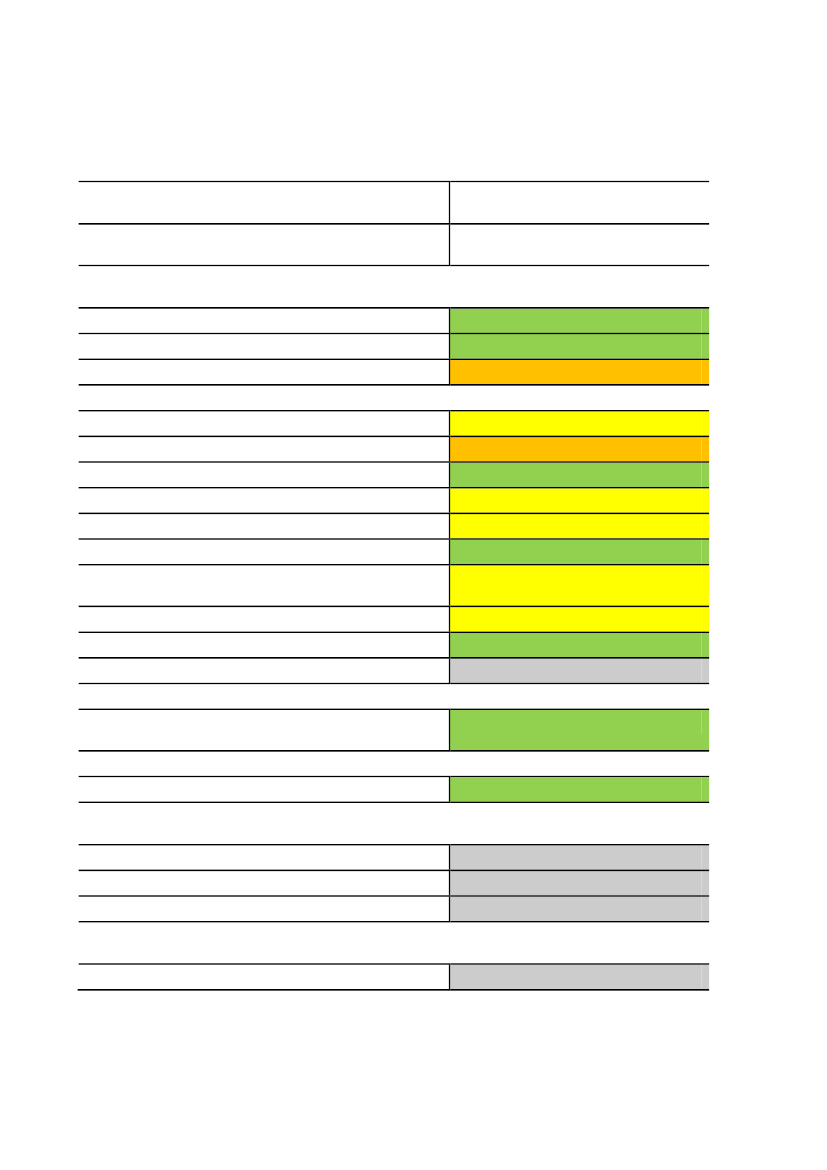Erhvervs-, Vækst- og Eksportudvalget 2013-14
L 133
Offentligt
Basel Committeeon Banking Supervision
Basel III regulatoryconsistency assessment(Level 2)Preliminary report:European UnionOctober 2012
This publication is available on the BIS website (www.bis.org).
�Bank for International Settlements 2012 All rights reserved. Brief excerpts may bereproduced or translated provided the source is cited.
ISBN 92-9131-149-9 (print)ISBN 92-9197-149-9 (online)
Contents
Foreword ............................................................................................................................... 1Assessment Team ................................................................................................................. 4Executive summary ............................................................................................................... 5Overview table of compliance grading ................................................................................. 12Response from the European Commission .......................................................................... 13Assessment ......................................................................................................................... 171.2.Introduction ........................................................................................................ 17Detailed findings ................................................................................................ 202.12.22.32.4Scope of application ................................................................................. 20Transitional arrangements ........................................................................ 21Definition of capital ................................................................................... 21Pillar 1: minimum capital requirements ..................................................... 272.4.1 Credit risk: standardised approach .................................................. 272.4.2 Credit risk: Internal ratings-based approach .................................... 302.4.3 Securitisation framework ................................................................. 382.4.4 Counterparty credit risk rules ........................................................... 392.4.5. Market risk: standardised method .................................................... 402.4.6 Market risk: internal models approach ............................................. 422.4.7 Operational risk: basic indicator approach and standardised ........... 42approach2.4.8 Operational risk: advanced measurement approaches .................... 432.4.9 Capital buffers (conservation and countercyclical) ........................... 442.52.6A.B.C.D.E.Pillar 2: Supervisory review process ......................................................... 44Pillar 3: Market discipline .......................................................................... 45
Annexes............................................................................................................................... 47Glossary ............................................................................................................ 47List of findings for follow-up assessment............................................................ 48Referenced documents...................................................................................... 49EU authorities met by the EU Assessment Team .............................................. 51List of EU banks ................................................................................................ 52
Basel III regulatory consistency assessment (Level 2) - European Union
ForewordThis report presents the conclusions of the Basel Committee’s Basel III1RegulatoryConsistency Assessment (“Level 2”) of the European Union (EU). The assessment in thisreport has been based mainly on the 5th Council Presidency’s compromise proposal agreedon 15 May 2012.2Considering the draft nature of the compromise proposal and inaccordance with the Committee’s agreed procedures for conducting a Level 2 assessment,3this assessment is considered preliminary.A follow-up assessment will take place oncethe EU authorities have published the final rules that implement Basel III.The report is based on information available at the time it was completed on 22 August 2012.The assessment was conducted over a six month period from March to August 2012,including face-to-face discussions in April 2012 and an on-site visit in July 2012. Thepreliminary findings of this assessment were published in a June report to the G20 leaders.4The assessment team consisting of six international experts was led by Mr Charles Littrell,Executive General Manager, Policy Research and Statistics, Australian PrudentialRegulation Authority.For purposes of this Level 2 assessment of the EU, the European Commission (EC) servedas the assessment team’s main counterpart. The bank data analysis that forms part of theassessment was coordinated directly with the nine BCBS member countries that are alsomembers of the EU.5The EC, as well as representatives from the nine EU-BCBS membercountries, the European Banking Authority (EBA) and the European Central Bank (ECB)participated in the meetings that were organised as part of the EU review.The assessment team sought data and supplementary information from a sample of largeinternationally active banks operating in the nine EU-BCBS member countries to assist in themateriality analysis. However, given the tight timeframes and competing priorities forEuropean banks and bank supervisors, the team did not receive complete and consistentdata from all the banks. As a result, the assessment team was not able to undertake acomprehensive quantitative materiality assessment within the available time. Theassessment team’s materiality conclusions are therefore primarily based on qualitative expertjudgement, augmented by data where applicable. The follow-up assessment should addressthe data limitations regarding materiality assessments.Furthermore, it should be noted that the current assessment excludes certain sections of theBasel III rules that are under review or are being finalised by the Basel Committee. Inparticular, the leverage ratio, the liquidity ratios and the framework for global systemically
1
Basel III builds upon and enhances the regulatory framework set out under Basel II and Basel 2.5 (ie the July2009 enhancements to Basel II), which now form integral parts of the Basel III framework. The assessmentsthus cover the full set of components, including those introduced by Basel II and Basel 2.5. This full set ofrequirements is collectively referred to in this report as “Basel III” or the “Basel framework”.See www.consilium.europa.eu/uedocs/cms_data/docs/pressdata/en/ecofin/130264.pdfThe Committee’s Level 2 assessment process is described in the documentBasel III regulatory consistencyassessment programme,available at www.bis.org/publ/bcbs216.htm.TheReport to G20 Leaders on Basel III implementationis available at www.bis.org/publ/bcbs220.htm.The nine countries are Belgium, France, Germany, Italy, Luxembourg, the Netherlands, Spain, Sweden, andthe United Kingdom.
23
45
Basel III regulatory consistency assessment (Level 2) - European Union
1
important banks (G-SIBs) have not been assessed. The EU’s implementation of these ruleswill be assessed once they are finalised by the Basel Committee.The report has been written in accordance with “exception-based reporting”, ie it focuses ondeviations that could lead to a less robust capitalisation of the banking sector than wouldotherwise have been achieved if the Basel framework had been implemented in full. As such,areas of compliance are not explicitly addressed, nor are domestic measures that strengthenthe minimum requirements. However, assessed jurisdictions were given the option to provideinformation on “super equivalence” to be included as an annex of the present document. Thisinformation on measures to strengthen the minimum requirements has not been assessednor are they endorsed by the assessment team.This Level 2 assessment report is part of a comprehensive review programme adopted bythe Basel Committee that comprises the following three levels:•Level 1: ensuring the timely adoption of Basel IIIThe objective of the “Level 1” assessment is to ensure that Basel III is transformedinto law or regulation according to the agreed international timelines. It focuses onthe domestic rule-making processes and does not include the review of the contentof the domestic rules. The Level 1 assessment is the foundation for theassessments at the other levels.•Level 2: ensuring regulatory consistency with Basel IIIThe “Level 2” assessment process assesses the compliance of domestic regulationsimplementing Basel III with the international minimum requirements defined by theBasel Committee. By identifying domestic regulations and provisions that are notconsistent with the rules agreed by the Committee and by assessing their potentialimpact on financial stability and on the international level playing field, this processwill promote full and consistent implementation of Basel III. It will also facilitate aneffective dialogue among members and provide peer pressure if needed. Theconclusions following each jurisdiction’s assessment will be published by theCommittee. This assessment programme supports the Financial Stability Board’smonitoring of the implementation of the agreed G20/FSB financial reforms and isconsistent with the “Coordination Framework for Monitoring the Implementation ofAgreed G20/FSB Financial Reforms” put in place by the FSB.6•Level 3: ensuring consistency of risk-weighted assetsThe objective of the “Level 3” assessments is to ensure that the outcomes of thenew rules are consistent in practice across banks and jurisdictions. It extends theanalysis of Levels 1 and 2, which focus on national rules and regulations, tosupervisory implementation at the bank level. This work is currently focusing on thereview and validation of how banks calculate their risk weighed assets.The Level 2 assessment methodology includes the following key elements:•The Level 2 assessment is factual in nature and focuses on reviewing thecompleteness (all required Basel III provisions have been adopted) and consistency
6
See the “CoordinationFramework for Monitoring the Implementation of Agreed G20/FSB Financial Reforms”put in place by the FSB at www.financialstabilityboard.org/publications/r_111017.pdf.
2
Basel III regulatory consistency assessment (Level 2) - European Union
(differences in substance) of domestic regulations (ie binding documents thateffectively implement Basel III independent of their label).••When a gap or difference is identified, a key driver for assessing compliance is itsmateriality and impact.To the extent possible, the materiality and impact is quantified using all availabledata, including those submitted by the jurisdiction being assessed. The assessment,in particular, seeks to measure the significance of any identified difference(s) forinternationally active banks. The assessment considers the current impact andconsequences, but also the potential impact of the difference(s) in the future. Theassessment team might also perform its own estimations and analyses, using allavailable sources of information and including in particular the Basel Committee’sQuantitative Impact Study (QIS) and Capital Monitoring Group (CMG) data.Specificities and drivers of local implementation are not taken into account whenassessing compliance: local specificities are not seen as mitigants for going beyondthe scope of national discretion specified within Basel III.Domestic measures that strengthen the minimum requirements are not consideredto compensate for inconsistencies or gaps identified elsewhere, unless they fullyand directly address the identified inconsistencies or gaps.The level 2 assessment is limited to regulatory issues and does not considersupervisory or bank practices. The extent to which Basel III is effectively enforced bysupervisors or whether firms are actually complying with the Basel III framework isassessed as part of the Level 3 assessment process.
•
•
•
All Level 2 assessments are graded using a four-grade scale: compliant, largely compliant,materially non-compliant and non-compliant:••Compliant: all minimum provisions of the international framework have beensatisfied and no material differences have been identified;Largely compliant: only minor provisions of the international framework have notbeen satisfied and only differences that have a limited impact on financial stability orthe international level playing field have been identified;Materially non-compliant: key provisions of Basel III have not been satisfied ordifferences that could materially impact financial stability or the international levelplaying field have been identified; andNon-compliant: Basel III has not been adopted or differences that could severelyimpact financial stability or the international level playing field have been identified.
•
•
The assessment team would like to thank the many Europeans who contributed to thisexercise. The EC coordinated the work on behalf of the EU countries, and materialassistance was received from the EBA, the ECB and the Basel Committee member agenciesfrom the nine EU countries.The assessment team leader also thanks the assessment team members, the agenciescontributing these staff and staff from the Basel Committee Secretariat for their valuablecontributions.
Basel III regulatory consistency assessment (Level 2) - European Union
3
Assessment Team
Team Leader:Mr Charles LittrellTeam members:Ms Margaret GriffinMs Anna Lee HewkoMs Sandy HoMr Satoshi IkedaMr Marc SalomoneSupporting members:Mr Juan-Carlos CrisantoMr Rajinder KumarMs Judy LauBasel Committee SecretariatBasel Committee SecretariatAustralian Prudential Regulation AuthorityReserve Bank of New ZealandUS Federal Reserve System Board of GovernorsMonetary Authority of SingaporeFinancial Services Agency of JapanSwiss Financial Market Supervisory AuthorityAustralian Prudential Regulation Authority
4
Basel III regulatory consistency assessment (Level 2) - European Union
Executive summaryThis report by the Level 2 assessment team for the European Union (EU) is applicableacross the EU. Consistent with the application of the Basel framework, the assessment teamconsidered the application of the EU regulations to “internationally active” banks.7Theassessment is based on draft EU level regulations. To assist in determining materiality, theassessment team used data from banks in nine countries that are members of both the BaselCommittee and the EU. The countries are: Belgium, France, Germany, Italy, Luxembourg,the Netherlands, Spain, Sweden, and the United Kingdom. For a limited number of issuesinvolving supervisory discretion, the assessment team also sought views from the ninemember countries. There was no data or other input from the EU Member States that are notBasel Committee members. Any observations in this assessment based upon data gatheredshould be read only as directly applicable to the nine Basel Committee members of the EU.
Status of EU rules textsThe EU implemented Basel I, Basel II and Basel 2.5 by Capital Requirements Directives(CRDs), which required transposition by Member States into their domestic legislation. Withthe implementation of Basel III, the EU has proposed a Capital Requirements Regulation(CRR) that does not require transposition into national legislation to ensure a commonapplication in all Member States. The proposed CRR, together with a new CRD, will replacethe existing CRDs. However, both proposed instruments are still in draft.In line with this, the current Level 1 assessment on the European Union indicates thefollowing status of Basel II, Basel 2.5 and Basel III implementation:
RulesBasel IIBasel 2.5Basel III
Grading442
Next steps –Implementation plans
5thCouncilPresidency'scompromise proposal agreed on15 May 2012; Draft EuropeanParliament Legislative Resolutionagreed on 14 May 2012; TheEuropean Parliament, Council andthe Commission currently indiscussions to agree on a final text
1 = draft regulation not published; 2 = draft regulation published; 3 = final rule published; 4 = final rule in force.Green = implementation completed; Yellow = implementation in process; Red = no implementation.
7
Paragraph 20 of Basel II notes that “(the) Framework will be applied on a consolidated basis to internationallyactive banks.” See Basel II: International Convergence of Capital Measurement and Capital Standards: ARevised Framework - Comprehensive Version (June 2006) available at www.bis.org/publ/bcbs128.htm.
Basel III regulatory consistency assessment (Level 2) - European Union
5
For the purpose of this exercise, the assessment team evaluated compliance based on theFifth Danish Compromise version of the CRDIV and CRR, agreed on 15 May 2012. TheEuropean Parliament has since published further updates to the documents and finalisationis expected by October 2012. Furthermore, the proposed CRR includes substantialreferences to technical standards and guidance to be developed by the European BankingAuthority (EBA). A number of legally binding technical standards, mostly pertaining to thedefinition of capital, have been released for consultation and the assessment team has takenthese draft standards into account in its review. A large number of technical standards,however, have yet to be drafted.Accordingly, consistent with the Level 2 assessment process agreed by the BaselCommittee, this assessment should be regarded as preliminary and will be supplemented ata later stage by a follow-up assessment when the EU rules are final and complete.
Compliance assessmentThe Level 2 methodology has identified materiality and impact as a key driver for assessingcompliance. For identified gaps and differences between Basel and the proposed EU rules,therefore, the assessment team has sought to quantify materiality to the extent possible. Inaddition, the assessment team not only considered current impact and consequences of thedifferences, but also their potential impact in the future.For overall compliance, the assessment team also took account of the impact on capitalratios where a bank adopts the proposed EU rules in full instead of following Basel in full.This measure was helpful for the assessment team to understand the potential aggregateimpact of a large number of individually immaterial differences. To this end, a group of 33banks, chosen based on a combination of asset size and cross-border importance, wasasked to calculate Common Equity Tier 1 (CET1), Tier 1 and Total capital ratios based onthe full Basel rules and separately based on the proposed EU rules. Given the tighttimeframes and competing priorities for European banks and bank supervisors, substantiallycomplete data was received from 13 banks only.Incomplete data has hampered the quantification process (as explained in Section 1 underData for materiality assessment).In recognition of the limitation, the team refrained fromusing the data outcomes as the sole driver to determine materiality. Instead, the team usedthe submitted data in a directional way to supplement the judgement of the team experts.The full team has confidence that the data available was adequate as a secondary input toeither:1.2.confirm the team experts’ views on items judged to be insignificant, where bankshave reported nil or near zero quantitative effects; orreinforce the team experts’ concerns that the identified differences could bepotentially material, with the submitted data showing substantial variances for someindividual banks.
In accordance with the Basel Committee’s methodology, the EU specific circumstances, andsurveillance and enforcement by national supervisors or the EBA, are not considered for thepurpose of this Level 2 assessment.
6
Basel III regulatory consistency assessment (Level 2) - European Union
Assessment findingsOverall gradingAs explained in the Foreword, considering the draft nature of the EU proposed rules thatimplement Basel III, this assessment is considered preliminary and therefore no overallgrading has been assigned at this stage. Once the final domestic regulations are publishedand the follow-up assessment has been carried out, an overall grading will be assigned inline with the Level 2 assessment process agreed by the Basel Committee.Sectional gradingsUsing a standardised assessment format, the assessment team has provided complianceratings on 14 key components of the Basel framework. Information on findings andcompliance ratings for each of the 14 elements is given in more detail later in this report.The assessment team has assessed 12 of the 14 key components as either “Compliant” (C)or “Largely Compliant” (LC). However, the proposed EU approach falls substantially short ofthe Basel framework in two areas: Definition of capital and the Internal Ratings-based (IRB)approach for credit risk. These components have been graded as “Materially Non-compliant”(MNC).This finding does not mean that every European bank’s reported capital ratios are materiallyhigher than would be the case under full compliance with the Basel framework. In the limitedsample of 13 internationally active banks available to the assessment team, for example, 10banks reported CET 1 ratio overstatements ranging from 0 to 50 basis points. On the otherhand, three of these banks reported CET1 ratio overstatements relative to the Baselframework exceeding 100 basis points. Furthermore, current pro forma differences mayunderstate the degree to which European bank capital ratios would vary from the Baselframework with the passage of time, as banks could be expected to optimise theirarrangements to meet the CRDIV/CRR requirements rather than to fully comply with theBasel framework.The Basel reforms to strengthen the global capital rules are aimed at achieving both a highquality capital base and a consistent definition of capital across jurisdictions. These factorsare present in the EU’s implementation of the Basel definition of capital rules, withcomprehensive transposition of the Basel capital criteria and adjustments into the proposedCRDIV/CRR. However, the assessment team has identified gaps and differences where keyBasel attributes have been either omitted or modified in the implementation process. Thesedeficiencies are described in the “Key issues” and the “Detailed findings” sections below.In response to the preliminary June 2012 report to the G20 Leaders and the on-sitediscussions, the assessment team received feedback from the EC and EU-Basel Committeemembers asserting that some departures from the Basel standard were necessary toaccommodate certain constraints, often arising from national legislation, in the EU’s differentMember States. Where relevant, the rationale is noted in the respective findings set outbelow but was not taken into account when assessing compliance, in accordance with theLevel 2 assessment methodology agreed and published by the Basel Committee.The draft CRR has introduced safeguards to limit the effect of these omissions/modificationsand the assessment team has given these safeguards due consideration. Putting asidesupervisory enforcement practices and monitoring measures by the EBA, which are notwithin the scope of the level 2 assessment, the team is concerned that internationally activeEU banks could take advantage of the modified rules in their capital structure. This
Basel III regulatory consistency assessment (Level 2) - European Union
7
potentially has material impact both in terms of financial stability and an international levelplaying field.The assessment team’s grading of the EU’s implementation of the IRB approach to creditrisk is largely based on the European application of permanent partial exemptions formaterial exposure portfolios. The EC has explained that the permanent partial exemptionwas not meant for internationally active banks. The data analysis, however, indicates amaterial proportion of exposures under the permanent partial exemption in many banks in anumber of EU Member States, with the majority of credit exposures subject to the exemptionzero risk weighted.
Main specific issuesDefinition of capital1.The CRR definition of CET1 for joint stock banks includes the 14 Basel frameworkcriteria,8but does not specify that the criteria must be met by common shares. TheEC’s explanation for the omission is that as company law is not harmonised amongthe EU Member States, there is no common definition of the term “common share”for the CRR to reference. To discourage instruments other than common sharesbeing included in CET1, Recital 53 of the CRR states that “it is expected that creditinstitutions or investment firms whose shares are listed on an EU regulated marketshould meet their capital requirements regarding the core elements of capital withthose listed common shares that meet a strict set of criteria for the core capitalinstruments and the disclosed reserves of the institution only”. The assessmentteam’s view is that the lack of specification in the CRR itself potentially leaves openthe possibility for the development of instruments, in addition to “common shares”, toqualify as CET1 in the EU. Even if the Recital is regarded as legally binding, it isexpressed as an expectation rather than a requirement and does not deal with non-listed entities. As a further safeguard, the EBA is tasked to establish, maintain andpublish a list of the instruments that qualify as CET1 in each Member State and tonotify the EC immediately where there is significant evidence of materialdeterioration in the quality of the listed instruments. As such, the EBA listing is anex-post measure to facilitate monitoring of approval practices in Member States. Theassessment team is concerned that “new” instruments on the list would be copiedquickly as Member States race to level the playing field within the EU, but at a levelpotentially below the international playing field.The CRR has modified three of the 14 criteria for application to mutuals andcooperatives. The EC explained that the modifications are necessary toaccommodate governing laws for mutuals and cooperative banks in some MemberStates. This is consistent with the Basel Committee’s stipulation that application ofthe CET1 criteria can take into account the specific constitution and legal structureof non joint stock companies. However, Basel is very specific that “the application ofthe criteria should preserve the quality of the instruments by requiring that they aredeemed fully equivalent to common shares in terms of their capital quality asregards loss absorption anddo not possess features which could cause thecondition of the bank to be weakened as a going concern during periods of market
2.
8
These criteria are set out from paragraph 53 ofBasel III: A global regulatory framework for more resilientbanks and banking systems(revised version June 2011), which is available at www.bis.org/publ/bcbs189.htm.
8
Basel III regulatory consistency assessment (Level 2) - European Union
stress”.9In this regard, the assessment team found the CRR modifications to limitthe CET1 holders’ claims and restrict maximum level of distributions bothacceptable, but had difficulty with the modification to allow co-operative banks toissue instruments redeemable at the option of the holder and include them as CET1.The team also considered redemption limitations proposed in the draft EBAtechnical standards but is concerned that if an institution has historically met allrequests for repayment of a capital instrument, it would be very difficult for theinstitution itself to delay or limit repayment without undermining confidence in theinstitution and putting it under additional stress. Also, any exercise of supervisorydiscretion to prohibit a non joint stock bank from repurchasing its capital instrumentswould also likely increase the market pressure on an already stressed institution.3.The Basel framework’s treatment of minority interests limits the amount that can berecognised in capital at the group level. The CRR proposes a more generoustreatment of minority interests for inclusion in the parent’s capital as it allows thesystemic risk buffer, the Pillar 2 buffer and the countercyclical buffer to be taken intoaccount when calculating the amount of minority interest to be recognised in theconsolidated capital. Inclusion of the first two buffers will likely have the effect ofcausing some permanent deviation vis-à-vis Basel rules, which could increasefurther in a situation where the countercyclical capital buffer is also in place. Themateriality would depend on the size of the Pillar 2, the countercyclical and systemicrisk buffers applicable to the consolidated subsidiary from which the minority interestarises.The Basel framework requires derecognition from CET1 of all unrealised gains andlosses from changes in fair value liabilities due to changes in a bank’s own creditstanding. The proposed CRR allows an offset for changes in fair value of hedges orother financial instruments also due to changes in the bank’s own credit standing.This difference could be highly material for a bank in financial difficulty that hasattempted to hedge its own credit position. The limited data review undertaken forthis element has already identified one bank with an offset amounting to more than10% of its CET1.Basel has adopted a broad definition of “indirect holdings” to minimise doublegearing. The CRR proposes a narrower definition of “indirect holding”, opening upthe potential for a bank to avoid any deduction of its exposures to the capital ofanother financial institution. This is apparently an inadvertent outcome in theproposed CRR, but is nonetheless a deficiency that has potential material impact onthe international level playing field.The CRR proposes to allow banks to consolidate significant investments ininsurance entities as an alternative to deducting the investments from CET1. Inaddition, the CRR has stipulated that the EBA, European Insurance andOccupational Pensions Authority (EIOPA) and European Securities and MarketsAuthority (ESMA) should jointly develop regulatory technical standards to specify theconditions of application of the calculation methods as alternatives to deduction.Basel is very specific that consolidation must result in a minimum capital standardthat is at least as conservative as that applicable under deduction. The assessmentteam has not been able to identify such a specification in the CRR. On the basis thatEU financial conglomerates can, subject to supervisory approval, potentially adopt
4.
5.
6.
9
Footnote 12 inBasel III: A global regulatory framework for more resilient banks and banking systems(revisedversion June 2011)
Basel III regulatory consistency assessment (Level 2) - European Union
9
the consolidation approach without regard to whether it would result in a lessconservative capital requirement, the assessment team judged this finding to bematerial in terms of international level playing field. The finding should be revisitedwhen the technical standards become available.7.The EU will implement the loss absorbency at the point of non-viability (PON)requirement through a statutory resolution regime. Domestic legislation will need tobe enacted to give effect to the Bank Resolution Directive.10Although a statutoryapproach is permitted under Basel, the EU’s implementation of the Basel PON lossabsorbency requirement is incomplete in a number of areas. Notable shortfallsinclude the failure to incorporate the PON loss absorbency requirement as aneligibility criterion for Additional Tier 1 (AT1) and Tier 2 instruments and to addressgroup treatment.11This finding is potentially material as EU banks may not berestricted to count AT1 and Tier 2 instruments as eligible capital notwithstandingadverse findings by the Basel peer review of the EU’s statutory approach.
Credit risk: Internal Ratings-based approachIn its implementation of the IRB approach, the EU provided for a “permanent partialexemption” under which an IRB bank may continue to risk-weight certain exposures basedon the standardised approach. The provision was meant to apply only in exceptionalcircumstances, not broadly. The data analysis confirms a restrictive application of theexemption in some national jurisdictions. However, in other national regimes, based on datafrom 16 banks, the notional amount of exposures to sovereigns exempted under Article145(1)(d) typically averages at 5.49%12of total exposures of the bank, with the most affectedbank reporting permanent partial use under this Article at around 20%. The assessmentteam recommends that the conditions for granting permanent partial use in practice and themateriality in terms of capital impact be further assessed under the Level 3 assessment.Maximum harmonisationIn its June 2012 preliminary report on the EU, the assessment team indicated it wouldconsider further whether the concept of a maximum harmonisation regulation, as proposedby the EU, is at odds with the concept of minimum requirements established in the Baselrules.The assessment team has concluded that the proposed EU concept is not inconsistent withthe Basel framework, albeit in a way which reflects the supra-national structure of Europeanregulation.1.The team considers that the “national authority” for European regulation should beinterpreted as the European level process of making regulations, directives andtechnical standards. It is clear that at this level, the relevant authorities could, if theychose, set higher standards than those applicable under the Basel framework.
1011
See http://ec.europa.eu/internal_market/bank/crisis_management/index_en.htmSee point 6 in the Annex to Final elements of the reforms to raise the quality of regulatory capital issued by theBasel Committee (January 2011)This does not include exposures enjoying exemption under article 145(d) in one of the countries reported to beaccounting for 15% of the total exposure of banks in that country ( the review team does not have the absolutefigures of these exposures).
12
10
Basel III regulatory consistency assessment (Level 2) - European Union
2.
Supervision is not centralised in Europe, but remains under the control of theresponsible national authorities. The review team is satisfied that the proposedEuropean regulation and other powers will give national supervisors sufficientflexibility, under Pillar 2 adjustments, to respond appropriately to identifiedshortcomings and other issues for individual banks. This is perhaps not as flexibleas allowing national supervisors to vary Pillar 1 requirements, particularly for issueswhich may be common risks across a number of banks. But the overall assessmentis that the combined regulatory and supervisory approach is sufficient to comply withthe Basel framework.
SummaryThe EU’s Basel implementation task is more complex than in other jurisdictions, given itsmembership. In most parts, the proposed CRDIV and CRR have fully transposed the Baselframework. The assessment team has, however, identified several key gaps and differences,some of which have been explained by the EC as necessary to address specific constraintsfaced by its Member States. In many cases, the CRR has provided safeguards or the EBAwill develop legally binding technical standards to limit the impact of the gaps or deficiencies.The EU has also asserted that “tailored supervisory approaches” by national supervisors tointernationally active banks would “remedy” the identified differences, which were intended toapply only to smaller banks. The assessment team has no reason to doubt that this wouldensue but subsequent implementation and enforcement are beyond the scope of this review.The Level 2 assessment has produced findings showing that the proposed CRDIV and CRRhave departed from the Basel framework in many areas. Some and possibly many of theidentified non-compliant items may be resolved as the CRDIV/CRR proposals progress totheir conclusion. The assessment team recommends a follow-up review of this report whenthe EU rule-making process is complete.
Basel III regulatory consistency assessment (Level 2) - European Union
11
Overview table of compliance grading
Key components of the Basel frameworkOverall GradeCapital requirementsScope of applicationTransitional arrangementsDefinition of capitalPillar 1: Minimum capital requirementsCredit Risk: Standardised ApproachCredit risk: Internal Ratings-Based approachCredit risk: securitisation frameworkCounterparty credit risk rulesMarket risk: standardised measurement methodMarket risk: internal models approachOperational risk: Basic Indicator Approach andStandardised ApproachOperational risk: advanced measurement approachesCapital buffers (conservation and countercyclical)G-SIB additional loss absorbency requirementsPillar 2: Supervisory Review ProcessLegal and regulatory framework for the SupervisoryReview Process and for taking supervisory actionsPillar 3: Market DisciplineDisclosure requirementsLiquidity standardsScope of applicationLiquidity Coverage RatioNet Stable Funding RatioLeverage ratioLeverage ratio
GradeNot yet assigned given the preliminarynature of the findings
(C)(C)(MNC)
(LC)(MNC)(C)(LC)(LC)(C)(LC)(LC)(C)(1)
(C)
(C)
(1)(1)(1)
(1)
Compliance assessment scale: C (compliant), LC (largely compliant), MNC (materially non-compliant) and NC(non-compliant). Definitions of the compliance scale are found in the foreword of this document. Ratings that arebased on draft or proposed rules are indicated within parentheses. Ratings based on final rules are indicatedwithout parentheses. (1) To be assessed after the Committee concludes its review on any revisions or finaladjustments of these elements of Basel III.
12
Basel III regulatory consistency assessment (Level 2) - European Union
Response from the European CommissionThe European Union remains firmly committed to the robust implementation of theinternationally agreed capital standards. It is of utmost importance that the Basel IIIagreement is applied consistently around the world, in order to ensure global financialstability and a level playing-field. Therefore, the European Commission fully supports theBasel Committee's intention to assess consistent implementation of these rules for allinternationally active banks worldwide and thanks the Basel Committee for the efforts madeso far.In 12 out of 14 areas of the present report, the draft European legislation has been fairlyassessed to be "compliant" or "largely compliant". The European Commission would like toexpress, however, its reservations about the preliminary findings and gradings in theremaining two areas, which do not appear to be supported by rigorous evidence and a well-defined assessment methodology. The European Commission is concerned that this has ledto an apparently significant lack of consistency in the way judgement and gradings have, inthis preliminary phase, been applied for those two areas across jurisdictions. The EuropeanCommission, and the European members of the Basel Committee, have provided extensiveinformation and clarifications to the Basel Committee during the process, but unfortunatelythis has only been partially reflected in the present report. The Commission stands ready tosupport the further work by the Basel Committee to improve its assessment of standardsimplementation and is confident that the final report of the Basel Committee will constitute animprovement both in the assessment of the EU and in the coherence across jurisdictions.The present preliminary report is based on the EU Council's general approach unanimouslyagreed by all Member States.13
The final legislation will be applied to more than 8,000 banksin Europe, representing more than 50% of world banking assets. Application to all banksnecessitates some flexibility for non-internationally active banks. However, at the same time,the proposed legislation gives supervisors the necessary tools to ensure that internationallyactive banks fully comply with Basel III.Intransparent section gradingIt is not transparent how the individual "potentially material" findings translate into a sectiongrading. In the case of the IRB, a single – questionable – finding, regarding permanent partialuse, seems to have turned the whole IRB section grading for the EU into "materially non-compliant." This does not seem justified given the unclear Basel rule on this point and theunquantified impact of this legislative choice on capital requirements. This finding is also notcomparable to the situation in the securitisation section of one other report, where a"materially non-compliant" grading has been attributed because a methodology for assigningcapital requirements is used that is not based on credit quality assessments and thereforecompletely different from Basel II.In the section about the definition of capital, a section grading of materially non-complianthas been assigned even though none of the seven "main specific issues" has been clearly
13
This "general approach" builds on the Commission's proposals of July 2011 and constitutes an important stepin the legislative process, but not the final legislation. The existing Basel II and Basel 2.5 agreements, whichform an integral part of Basel III, have already been implemented for all EU banks in accordance with theinternationally agreed timeframe. For Basel 2, a phased implementation starting in 2006 and for Basel 2.5, anunambiguous start date of 31 December 2011 have been agreed internationally.
Basel III regulatory consistency assessment (Level 2) - European Union
13
demonstrated to be material. Moreover, the assessments of these issues contain materialshortcomings, which are explained further below. At the same time, again comparing withone of the other reports, a similar number of individual findings in the definition of capitalsection that are comparable, or even identical, on substance lead to a section grading of"largely compliant".Shortcomings in individual findingsThe report fails to explain what quantitative importance a finding must have in order to beclassified as material. Moreover, the "main specific issues" identified in the report are in allinstances of "potential", rather than actual, materiality. The findings are usually ascribed toconcerns about possible future behaviour by banks and their supervisors. However, it isnever spelled out what future behaviour has been assumed by the assessors for this"potential" to materialise. Worse still, it appears that assumptions have not been madeconsistently across the three jurisdiction assessments. It appears that in the other tworeports, more often than in the EU report, findings have been considered non-material basedon an expectation that they will be mitigated by informal rules or certain behaviour ofsupervisors. A case in point is the recognition of capital instruments, where the proposedrules in one of the other two assessed jurisdictions give supervisory authorities far greaterleeway than the EU rules do. However, only in the EU report there seems to be anassumption that competent authorities will not act appropriately, despite the existingsafeguards of disclosure and discipline through the European Banking Authority.It appears that at times, individual bank data has been used, but no account is given of thespecific instance of the bank in question and of whether or not the relevant finding canplausibly be extrapolated to other banks. A case in point is the finding on non-joint stockcompanies. This indeed concerns a single internationally active bank. It is unclear that theissue is really material in the specific case and it is unreasonable to assume that a similarconcern, which is specific to the cooperative legal form and applicable laws in one MemberState, could arise at other internationally active banks. Another instance is the permanentpartial use of the IRB. The concern seems to relate to the observation that up to "around20%" of the exposures of one of the banks surveyed are treated under the standardisedapproach instead of the IRB approach. However, the average for the surveyed banks is only5.49% and no estimate of the impact on capital requirements is provided in order to confirmthe materiality of the finding. Notably, when comparing again the three reports, it turns outthat the Basel Committee's assessors are much less concerned if in another jurisdiction, allinternationally active banks are still subject to the outdated Basel 1 framework and this leadsto around 20% lower capital requirements overall according to local supervisors. In any case,the finding is questionable given that limited permanent and transitional partial use is inprinciple allowable according to the Basel II accord and it is not clear that the identified partialuse in the EU banks goes beyond the allowable extent envisaged by the Basel Committee. Itis also not clear that the impact of applying the Standardised rather than the IRB approach tothe exposures in question is actually material in terms of resulting capital requirements. Asmentioned above, the grading in the IRB approaches section is based on a single finding thathas been considered material. Regarding the definition of capital section, there are thefollowing concerns with the individual findings:Common shares:The CRR requires that the instruments fall under the Article 22 ofDirective 86/635 and that these instruments meet the 14 criteria set by the Basel IIIagreement." The term "common share" that is used in the Basel III agreement is not definedin European legislation and different definitions of common shares exist in Member Statecompany law. For this reason, the articles of the proposed regulation do not use the termcommon share, which the preliminary report correctly points out. The preliminary reporthowever fails to show that the instruments that will be eligible under the proposed regulationand meet the substance of the 14 criteria could indeed fall short of the Basel Committee's
14
Basel III regulatory consistency assessment (Level 2) - European Union
expectations as to what "common shares" deliver. Moreover, the recital No. 53 explaining therelevant stipulations clearly expresses the legislator's expectations that the instruments areindeed "common shares" for banks that have such shares listed on a regulated market – thereport does not explain why it expects supervisors not to live up to the legislators'expectations. It would have been fair to announce further work in the "level 3" assessment,but the report does not do it. In the case of one other assessment, on a similar issue, theassessors have been satisfied with a simple promise from the local authorities to use theirdiscretions only "in case of emergencies" and to disclose the use when it occurs. Notably, thepublic disclosure of all instruments recognised is also a requirement in the draft EU law.Treatment of insurance subsidiaries:The assessment team concludes that the impact ismaterial, disregarding that the issue can arise only in very few banks that formally constitute"financial conglomerates". Further, as the report concedes, the verdict is made withoutactually knowing what the consolidation method, which is still being defined, is and what itsprecise impact will be. However, even absent a detailed definition of the consolidationmethod it is clear that the additional consolidation at the level of the conglomerate effectivelyprevents double gearing. It ensures that at least the capital requirements of the insurancesubsidiary have to be supported by consolidated capital of the group. The approach isprudentially sound, not least because by contrast to a simple deduction it avoids negativeincentives for the level of capital held at the insurance subsidiaries. It should be noted thatdraft rules in another jurisdiction also allow for a consolidation method as an alternative todeduction, but this seems not to have affected the section grading for that jurisdiction in thesame way.Loss absorbency at the point of non-viability:The absence of a requirement for acontractual clause to that effect can have some transitional impact, but that impact cannot bematerial once a statutory regime will be introduced with the adoption of the bank resolutionproposals. This proposal will enter in force at most two years later than the legislationimplementing Basel III. However, given that Basel III requires a phasing out of 10% of therelevant instruments only in 2014, there is no impact of this difference in 2013 and anegligible impact in 2014.Minority interests:The additional discretionary capital requirements that can be included inthe minority interests are likely to be of low materiality. Moreover, the proposed treatment issound, as only minority interest that are used to meet legally binding capital requirements atthe level of subsidiaries are included in the consolidated capital. In that sense, Pillar 1 and 2capital requirements as well as systemic risk and countercyclical buffer requirements are allequivalent. In particular, the EU Council has introduced the systemic risk buffer as afunctional equivalent to higher Pillar 1 capital requirements in order to give Member States'public authorities some flexibility; and Pillar 1 capital requirements are actually included inthe Basel II eligible minority interests. In addition, some supervisors have indicated that thecurrent Pillar 2 requirements had been introduced to pre-empt the more stringent Pillar 1minima under Basel III; hence, once the new rules will enter in force, they will be materiallyreduced as will be the related minority interests.Non-joint stock companies:The Basel III agreement recognises in a footnote theparticularities of non-joint stock companies. This recognition is also reflected in the EU draftlaw and should not be seen as a compliance issue. Moreover, it is unclear what the report'sview on materiality is based on. According to information provided by the EU supervisors tothe assessment team, there is a single internationally active bank that can only issuecooperative shares that are, subject to conditions, redeemable. It is not a case where it couldbe reasonably assumed that other internationally active banks would turn into cooperativesand get into the same position in the future. At the same time, the actual impact of potentialredemption on that one bank's capital position has not even been assessed; even in the caseof that bank, it is not clear whether potential redemptions could become material given that
Basel III regulatory consistency assessment (Level 2) - European Union
15
the redeemable share capital as opposed to reserves etc constitutes only a fraction of CET1capital for cooperative banks.
16
Basel III regulatory consistency assessment (Level 2) - European Union
Assessment1.Introduction
Overview of the EU banking sectorBanks remain the dominant suppliers of financing in the EU representing 75% of thecombined assets of banks, insurance corporations, and pension and investment funds.Comparing the supply of credit with the size of capital markets, bank credit comprises half ofthe sum of credit, stock market capitalisation and outstanding debt securities in the EU.Despite the financial crisis and the stagnating assets in nominal terms, bank intermediation inEU in relation to GDP represents on average 360% (and 120% on average in new EUmember countries), mainly reflecting the decline experienced in GDP.14There are more than 8,000 deposit taking credit institutions in the EU of which around 6,800are banks.15Fifteen of these banks have been designated global systemically important bythe Financial Stability Board.16However, according to the EC, the proposed CRDIV/CRRrules will continue to apply to around 8,000 firms, including credit institutions and investmentfirms, not just banks.17In terms of concentration, banking assets of the top 6 and 10 banks in the EU, as apercentage of total banking assets, account for 24% and 35% respectively.18The bankingmarket is dominated by pan-European groups active in several Member States. Currentlyaround 70% of EU banking assets is in the hands of some 40 banking groups withsubstantial cross-border activities. Especially in the EU countries, banking markets aredominated by foreign (mostly Western European) financial groups. In these countries, onaverage 65% of banking assets are in foreign-owned banks.According to the ECB reported data, at the end of 2010, EU-based banks had a Tier 1 capitalratio of 10.42%. The same ratio was estimated at 7.7% in 2007.19Looking at the largest 90banks in the EU, in the context of the July 2011 stress tests conducted by the EBA, theywere calculated to hold, on average, Tier 1 capital ratio of 8.9%.20With respect to a subset of71 banks,21EBA made a formal recommendation to national authorities that these banksraise their Tier 1 capital ratio to 9%, after accounting for an additional buffer against
1415161718192021
European Central Bank, EU Banking Structures, September 2010.European Banking Federation, EU Banking Sector, Facts and Figures 2011/2012.www.financialstabilityboard.org/press/pr_111104cc.pdfEuropean Commission response to the Level 2 Self-Assessment Questionnaire.See European Banking Federation above.See European Banking Federation above.European Banking Authority, 2011 EU-wide Stress Test Aggregate Report, July 2011.The sample included all the 90 banks that participated in the 2011 EU-wide stress test although the EBAconsidered it appropriate to exclude a subset of small non cross-border banks from the package. The totalsample encompassed 71 banks.
Basel III regulatory consistency assessment (Level 2) - European Union
17
sovereign risk holdings.22EBA has recently expressed that these banks are generally ontrack to comply with its recommendation.23
Broader context of the level 2 assessmentThe regulatory consistency assessment (Level 2) for the European Union is part of theFinancial Stability Board’s (FSB) mandate of monitoring the implementation of the agreedG20/FSB financial reforms. The Level 2 assessment seeks to assess regulatory consistencywith the Basel framework. Specifically, the Level 2 process is meant to1.Identify the domestic regulations and provisions that are, in terms of content (iescope and substance) not compliant with the rules agreed by the Basel Committee;andAssess the potential materiality of the deviations and impact on financial stabilityand the international level playing field.
2.
It should also be noted that the Basel Committee’s implementation assessment programmecomplements the Financial Sector Assessment Program,24which is conducted by theInternational Monetary Fund and the World Bank. In particular, the Basel implementationassessment provides a comprehensive examination of regulatory consistency with theagreed Basel framework, while the FSAP considers the full range of the regulatoryframework and supervisory practices.
Documents used for the assessmentThe Level 2 assessments are benchmarked against Basel II, 2.5 and Basel III rules. SomeBasel III rules were left out because they are still in the process of being completed by theBasel Committee. This applies for the framework for global systemically important banks (G-SIBs), the liquidity requirements and the leverage ratio.25For a complete list of Baseldocuments that are included in the assessment, see Annex C.Regarding the EU documents, the assessment is based on 5th Presidency CouncilCompromise Proposals.26In addition, assessment takes into account a number ofcomplementary documents issued by the EU authorities. See, for an overview of the EUpublic documents that have been consulted, Annex C.
22
European Banking Authority, Recommendation on the creation and supervisory oversight of temporary capitalbuffers to restore market confidence, December 2011.European Banking Authority, Update on the implementation of Capital Plans following the EBA’s 2011Recommendation on the creation of temporary capital buffers to restore market confidence, July 2012.The FSAP assesses country’s compliance with the Basel Committee’s Core Principles for Effective BankingSupervision (BCPs).See www.bis.org/publ/bcbs216.pdf, p.8, for an overview.Council of the European Union, PROPOSAL FOR A DIRECTIVE OF THE EUROPEAN PARLIAMENT ANDOF THE COUNCIL on the access to the activity of credit institutions and the prudential supervision of creditinstitutions and investment firms and amending Directive 2002/87/EC of the European Parliament and of theCouncil on the supplementary supervision of credit institutions, insurance undertakings and investment firmsin a financial conglomerate - Council general approach, 15 May 2012. Council of the European Union,PROPOSAL FOR A REGULATION OF THE EUROPEAN PARLIAMENT AND OF THE COUNCIL onprudential requirements for credit institutions and investment firms - Council general approach, 15 May 2012.
23
24
2526
18
Basel III regulatory consistency assessment (Level 2) - European Union
Data for the materiality assessmentOne of the factors that the assessment team took into account for the materiality assessmentof its findings was the data received through the data requests. Via the national supervisors,the assessment team sought data from an agreed sample of 33 banks, chosen based on acombination of asset size and cross-border importance. Given the tight timeframes andcompeting priorities for European banks and bank supervisors, the team did not receive datafrom all banks. Furthermore, a full data set was not provided by every bank that responded.After applying quality checks, data from a subset of 20 banks was used for the materialityanalysis. The assessment team’s deliberations were therefore based on a partial datasample. Within the subset of 20 banks, 13 banks reported data that allowed the team toassess the pro forma differences in overall capital ratios.The objective of the data analysis was not to quantify the impact of every individualdifference between the proposed EU and Basel rules. Team experts sought data only onitems of difference identifed as potentially material, and used the data aggregates andranges computed to supplement their qualitative assessment on materiality.All bank level data has been provided by the national supervisors to the BCBS Secretariatmembers working with the assessment team. The confidentiality protocol does not allow theassessment team members to access data that would allow identification of an individualbank.
EU review visitOn 16-20 April, the leader of the EU Review Team held face-to-face discussions with seniorrepresentatives from the EC, the nine EU-BCBS countries, EBA and the ECB. The purposeof these meetings was to share the work programme of the assessment team and to providean initial indication of the areas where the team would be focusing its work.
Preliminary reportOn 11 June, the EU Review Team shared the preliminary findings of its work as part of theBasel Committee’s “Report to G20 Leaders on Basel III Implementation”.27This initialassessment identified a large number of features of the current EU Basel III proposals thatrequired further investigation but anticipated that most of these issues had the potential toprove either consistent with the Basel framework, or immaterial in practice. Similarly, theinterim report highlighted a small number of issues (ie maximum harmonisation, definition ofcapital and the credit risk’s internal ratings-based approach) as potentially material and inneed of a detailed assessment by the review team.
On-site review meetingsFrom 9 July until 13 July, the assessment team held on-site review meetings in Brussels.The main objective of these meetings was to discuss in detail the team’s provisional list ofinconsistent items between Basel III and the corresponding European proposals. The teamalso took advantage of the on-site review to share the preliminary results of its banking datamateriality analysis.
27
www.bis.org/publ/bcbs220.htm, pages 7 to 10.
Basel III regulatory consistency assessment (Level 2) - European Union
19
The EC hosted these meetings and was the main counterpart of the review team during thetechnical discussions. The nine EU-BCBS countries as well as EBA and the ECB wereinvited to take part in these meetings and importantly contributed to the discussions.During the week of the on-site review meetings in Brussels, the leader of the EU review teamalso met with senior representatives from the European Parliament and the Presidency of theEuropean Council to discuss key aspects of the work of the EU Review Team.
2.
Detailed findings
In the next sections, the detailed assessment findings are presented together with anassessment of their materiality. The sections correspond with the sections in the overviewtable on page 12.As remarked in the foreword, only deviations that could lead to a less robust capitalisation ofthe banking sector are reported. Areas of compliance are not explicitly addressed, nor areareas where the EU approach would be super-equivalent vis-à-vis the Basel standards.Areas where the domestic rules strengthen the minimum requirements have not been takeninto account in the section gradings.The following findings are not in order of importance, but in the order of assessment throughthe relevant Basel rules texts.
2.1
Scope of application(Compliant)Overall, the CRR/CRDIV is assessed as compliant with the Baselscope of application. Although there are a few differences, theirimpacts are unlikely to be material.
Section GradingSummary
Overview of findings by Basel II paragraph(s):Basel paragraph(s)Reference in the domesticregulationFindings28: Treatment of significant minority interestCRR: Articles 16-17There are a few instances where the CRR allows exceptionaltreatments of prudential consolidation which may not be fullycompliant with the Basel texts. One example is that pro rataconsolidation could be permitted beyond the minority-owned entities inthe EU. That said, the exceptions are mostly subject to supervisoryapproval or under strict thresholds for the application.Materiality was not assessed quantitatively as the team expertsconsidered the impact would not be material for the internationallyactive banks of the EU.
Materiality
20
Basel III regulatory consistency assessment (Level 2) - European Union
2.2
Transitional arrangements(Compliant)CRR allows jurisdictions to waive the application of the Basel I floorbut data analysis suggests that the finding is not material.
Section GradingSummary
Overview of findings by Basel II paragraph(s):Basel paragraph(s)Reference in the domesticregulationFindings45-49: Transitional arrangements (amended by BIS press release 13July 2009)CRR: Article 476Basel II introduced a Basel I floor as a transitional arrangement. InJuly 2009, the BCBS decided to keep in place the Basel I capitalfloors beyond the end of 2009. The CRR allows jurisdictions to waivethe application of the Basel I floor but there is no guidance for suchwaivers. The CRR also permits an alternative calculation of the floorbased upon the Basel II standardised approach.The data analysis indicates that the finding is unlikely to be material.
Materiality
2.3
Definition of capital(Materially non-compliant)The assessment team considered the following findings to havematerial impact on the consistency in the definition of capital acrossjurisdictions:••••••no stipulation that CET1 must be “common shares”;redemption on demand for “CET1” instruments issued bymutuals and cooperative institutions in some Member States;offset against unrealised gains/losses due to changes inbanks’ own credit standing;narrow definition of “indirect holdings”;consolidation of insurance entities; andincomplete implementation of the PON loss absorbencyrequirement.
Section GradingSummary
In addition, there are other differences between the CRR and Baselwhich, though not material in isolation, may in aggregate havesignificant impact on the quality and level of bank capital in thefinancial system, especially in times of stress.Overview of findings by Basel III paragraph(s):Basel paragraph(s)Reference in the domesticregulationFindings52- 53: Common Equity Tier 1CRR: Articles 24, 26, 75, and 424(1)(a) and Recital 53Basel stipulates that internationally active joint stock companies mustmeet the 14 criteria for CET1 instruments solely with common shares.The CRR requires instruments to satisfy the 14 criteria to qualify asCET1 capital but makes no reference to the “common shares”
Basel III regulatory consistency assessment (Level 2) - European Union
21
requirement. The EC explained that since company law is notharmonised among the EU countries, there is no common definition ofthe term “common share” for the CRR to reference. Furthermore, theterm “common share” is not used in some Member States. Accordingto the EC, the 14 criteria define a common share so meeting the 14criteria is adequate to give effect to the Basel requirement.To safeguard against instruments other than common shares gettingincluded, Recital 53 of the CRR states that “it is expected that creditinstitutions or investment firms whose shares are listed on an EUregulated market should meet their capital requirements regarding thecore elements of capital with those listed common shares that meet astrict set of criteria for the core capital instruments and the disclosedreserves of the institution only”. But this is expressed as anexpectation rather than a requirement, and does not deal with non-listed entities.The EBA is also tasked to establish, maintain and publish a list of theinstruments that qualify as CET1 in each Member State and to notifythe EC immediately where there is significant evidence of materialdeterioration in the quality of the listed instruments. As such, the EBAlisting is an ex-post measure to facilitate monitoring of approvalpractices in Member States.MaterialityMateriality could not be assessed quantitatively. The team expertsconsidered this finding to be potentially material as the lack ofspecification of the requirement in the CRR itself potentially leavesopen the possibility for the development of instruments, in addition to“common shares”, to qualify as CET1.53 footnote 12: Application of Common Equity Tier 1 criteria to non-joint stock companiesCRR: Articles 24-28, 72, 73, 75, and 424(1)(a)The CRR has modified the 14 criteria for mutual and co-operativeinstitutions in the following aspects:•instead of requiring that CET1 instruments give holders a claimon residual assets, the CRR allows instruments a fixed claimlimited to the nominal value of the instruments in the event ofinsolvency or liquidation subject to the limitation being applied toall other CET1 instruments issued by the institution;where refusal to redeem is prohibited by national law, theinstrument may be redeemed subject to limits. Redemption issubject to the institution obtaining the prior permission of thesupervisor in a manner that is permitted under national law. Thisis contrary to the Basel criteria that an instrument must never berepaid outside of liquidation, and that there is no expectation atissuance that the instrument will be redeemed;the instrument may include a cap or restriction on the maximumlevel of distributions where that cap or restriction is specifiedunder national law or the statute for that institution. This departsfrom the Basel requirement that distributions must not besubject to a contractual cap.
Basel paragraph(s)Reference in the domesticregulationFindings
•
•
To limit the scope of the modifications, the CRR requires the EBA todevelop regulatory technical standards to specify the nature oflimitations on redemption necessary where the refusal of theinstitution to redeem is prohibited under applicable national law. TheEBA has issued draft technical standards proposing that the ability ofan institution to limit redemption shall encompass both the right to
22
Basel III regulatory consistency assessment (Level 2) - European Union
defer redemption and the right to limit the amount to be redeemed foran unlimited period having regard to, in particular, but not limited to,the overall financial, liquidity and solvency situation of the institutionand the institution’s capital position. The EBA proposals also specifythe nature and extent of the features that could cause the condition ofan institution to be weakened as a going concern during periods ofmarket stress and the market stress under which such features couldcause the condition of the institution to be weakened as a goingconcern.While Basel notes that the 14 criteria to classify common shares asCET1 are also applicable to non-joint stock companies, taking intoaccount their specific constitution and legal structure, the applicationof the criteria should preserve the quality of instruments by requiringthat they are deemed fully equivalent to common shares in terms ofloss absorption and absence of features that could cause thecondition of the bank to be weakened as a going concern in times ofstress.The assessment team do not consider that instruments redeemable atthe option of the holder, albeit subject to the limitations set out in theEBA regulatory technical standards, can be deemed equivalent tocommon shares in terms of loss absorption. If an institution has inpractice been meeting all requests for repayment of a capitalinstrument, it would be very difficult for the institution itself to delay orlimit repayment, or for the supervisor to refuse consent for arepayment, without undermining confidence in the institution andputting it under additional stress.MaterialityBasel paragraph(s)Reference in the domesticregulationFindingsThe data analysis indicates that the finding is potentially material for afew internationally active banks.62- 65: Minority interestCRR: Articles 76- 83The Basel adjustments for minority interest are based on the minimumcapital requirements plus the capital conservation buffer.The CRR allows, in addition to the above elements, the systemic riskbuffer, Pillar 2 buffer and the countercyclical buffer to be taken intoaccount when calculating the amount of minority interest to berecognised in consolidated capital. This has the effect of increasingthe amount of minority interest recognised in the parent bank’s capital.While the inclusion of the systemic risk buffer, Pillar 2 buffer will likelyhave the effect of causing some permanent deviation vis a vis Baselrules, the countercyclical capital buffer, when in place, will have theeffect of increasing this deviation further. The EC explained thatMember States were concerned that Basel rules would lead to capitalin subsidiaries being reduced if recognition of minority interests werelimited to the extent of the conservation buffer.MaterialityBasel Paragraph(s)Reference in the domesticregulationFindingsThe data analysis indicates that the finding is potentially material for afew internationally active banks.75: Cumulative gains and losses due to changes in own credit risk onfair valued financial liabilities.CRR: Article 30Basel derecognises in the calculation of CET1, all unrealised gainsand losses resulting from changes in the fair value of liabilities that aredue to changes in the bank’s own credit standing. The CRR provides
Basel III regulatory consistency assessment (Level 2) - European Union
23
for an exception by allowing such gains and losses to be offset by achange in the fair value of another financial instrument resulting fromchanges in the bank’s own credit standing. This means that a failingbank could owe money on out-of-the-money hedges because theholders of these liabilities will demand full repayment, rather than adiscounted market value, while the underlying mark-to-marketdiscount on liabilities evaporates.The EC’s explanation that the exception is consistent with IFRS doesnot change the fact that the finding is a departure from Basel.MaterialityThe team experts considered this finding to be potentially material asthe CRR treatment of allowing offsets could result in materially highercapital ratios particularly for banks that are under stress.80 footnote 26: Definition of indirect holdingsCRR: Article 22(17)Under Basel rules, an indirect holding of capital arises when a bankinvests in an unconsolidated intermediate entity to gain an exposureto the capital of another financial institution. The CRR defines “indirectholding” as a direct holding of capital instruments issued by anintermediate entity that has an exposure to capital instruments issuedby a financial sector entity where, in the event the capital instrumentsissued by the financial sector entity were permanently written off, theloss that the institution would incur as a result would not be materiallydifferent from the loss the institution would incur from a direct holdingof those capital instruments issued by the financial sector entity.By restricting the definition to holdings of capital instruments, the CRRwould not capture exposures to financial sector entities gainedthrough other forms of investments in the unconsolidated intermediateentity.MaterialityMateriality could not be assessed quantitatively. The team expertsconsidered this finding to be potentially material as the CRR definitioncould encourage banks to attempt highly structured arrangements toavoid the capital effects of holding capital in another financialinstitution.83: Pro rating of investments below the thresholdCRR: Article 43(4)Under Basel rules direct, indirect and synthetic investments in thecapital of financial sector entities that are outside the scope ofregulatory consolidation must be deducted from capital above athreshold. Amounts below the threshold which are not deducted willcontinue to be risk weighted. For the application of the risk weightingthe amount of the holdings must be allocated on a pro rata basisbetween those above and those below the threshold.The CRR does not explicitly specify pro rating of holdings above andbelow the threshold for the application of risk weightings and thereforebanks could allocate holdings in a way that maximises the bank’scapital leading to an overstatement of the bank’s capital positions. TheEC disagrees with our interpretation but acknowledges that the CRRis not worded in a way that is sufficiently clear.MaterialityBasel paragraph(s)Materiality was not assessed quantitatively as the team expertsjudged this finding unlikely to be material.84-85: Investments in the capital of insurance entities
Basel paragraph(s)Reference in the domesticregulationFindings
Basel paragraph(s)Reference in the domesticregulationFindings
24
Basel III regulatory consistency assessment (Level 2) - European Union
Reference in the domesticregulationFindings
CRR: Article 46Under Basel rules, jurisdictions can permit or require banks toconsolidate significant investments in insurance entities as analternative to the deduction approach on the condition that the methodof consolidation results in a minimum capital standard that is at leastas conservative as that which would apply under the deductionapproach. In order to ensure this outcome banks that apply aconsolidation approach are required to calculate their capital ratiosunder both the consolidation approach and the deduction approach, ateach period that they report or disclose these ratios. In cases wherethe consolidation approach results in lower capital ratios than thededuction approach banks must report these lower ratios. If theconsolidation approach results in a higher capital ratio than thededuction approach the bank must adjust the ratio downwardsthrough a regulatory adjustment.The CRR allows, subject to supervisory approval, using aconsolidation approach as an alternative to deduction, but does notmandate the critical additional requirement that any consolidationmethod must not produce a capital ratio benefit compared todeduction. The CRR also provides that the EBA, EIOPA and ESMAshould jointly develop regulatory technical standards to specify theconditions of application of the calculation methods as alternatives todeduction.
Materiality
The finding is material, with the potential for financial conglomeratesto report materially higher capital ratios than would apply in a regimefully compliant with the Basel framework. It is possible that upcomingtechnical standards could correct this defect, but there is no statutoryinstruction to the national authorities to ensure this outcome.90: Former deductions from capitalCRR: Articles 33(1)(k), 85 and 369Basel applies a risk weight of 1250% to certain items which werededucted 50 % from tier one and 50% from tier two (or had the optionof being deducted or risk weighted).The CRR allows banks to deduct these items from CET1 as analternative to applying a risk weight of 1250%. This is a deliberatedeparture from Basel.In most cases using a deduction approach will result in a highercapital ratio than risk weighting at 1250%.
Basel paragraph(s)Reference in the domesticregulationFindings
MaterialityBasel paragraph(s)Reference in the domesticregulationFindings
The data analysis indicates that the finding is unlikely to be material.95: Transition for CET1CRR: Articles 463-464Basel allows instruments that do not meet the CET1 criteria to begrandfathered as CET1 only if they are issued by a non-joint stockcompany. The CRR allows grandfathering as CET1 instrumentsissued by joint-stock companies that today qualify as core T1 capitalunder national implementations of the CRD, notwithstanding that theydo not meet the CET1 criteria.The data analysis indicates that the finding is unlikely to be material.96: Eligibility for transitional arrangements
MaterialityBasel paragraph(s)
Basel III regulatory consistency assessment (Level 2) - European Union
25
Reference in the domesticregulationFindings
CRR: Article 463To qualify for Basel transitional arrangements under paragraph 94,capital instruments must be issued before 12 September 2010. TheCRR grandfathering provisions apply to capital instruments issuedbefore 31 December 2011.Materiality could not be assessed due to lack of data.BIS press release 13 January 2011: Loss absorbency at point ofnon-viabilityCRR: Recital 27Bank Resolution Directive: 51-55, 115The EU will implement the loss absorbency at the point of non-viability(PON) requirement through a statutory resolution regime. The ECexplained that the resolution authorities in the EU will, aftertransposing the Bank Resolution Directive into domestic legislation,have the power to write down AT1 and T2 capital instruments issuedby banks at pre-defined trigger events (eg a bank is judged no longerviable or a decision is made to provide extraordinary support to abank).Although a statutory approach is permitted under Basel, the EU’simplementation of the Basel PON loss absorbency requirement isincomplete as the Bank Resolution Directive does not address all theBasel PON criteria.First, the EU has so far failed to incorporate the PON loss absorbencyrequirement as an eligibility criterion for AT1 and T2 capitalinstruments. Basel stipulates that AT1 and T2 instruments will notqualify as regulatory capital from 1 January 2013 unless theinstruments have a PON loss absorbency feature. EU Member Statesare expected to transpose the Bank Resolution Directive into theirnational legislation by 31 December 2014. As a result, EU banks maynot disqualify AT1 and T2 capital instruments that do not have thePON loss absorbency feature from 1 January 2013.Second, Basel has stipulated group treatment when issuing banks arepart of a wider banking group. Neither the CRR nor the BankResolution Directive addresses group treatment. The consequence isthat EU banks may receive more generous recognition of regulatorycapital at the group level than banking groups complying with Basel.Third, for a statutory approach to be acceptable as an alternative tothe contractual approach, it must be confirmed by a peer review. It ispossible that some EU Member States could fail the peer reviewbecause the transposition of the Directive into national legislation wasineffective. There is no provision in the CRR to disqualify the AT1 orT2 instruments issued by affected banks of such Member States.Last, Basel requires the relevant regulator and the issuing bank todisclose the statutory approach in issuance documents of anyinstruments subject to the PON loss absorbency requirement bylegislation. The EU has yet to implement such a disclosurerequirement.
MaterialityBasel paragraph(s)Reference in the domesticregulationFindings
Materiality
This finding is potentially material as EU banks may not be restrictedto count AT1 and Tier 2 instruments as eligible capital notwithstandingadverse findings by the Basel peer review of the EU’s statutoryapproach.
26
Basel III regulatory consistency assessment (Level 2) - European Union
2.42.4.1
Pillar 1: minimum capital requirementsCredit risk: standardised approach(Largely compliant)There are a number of variances from the Basel framework, somewith the potential to be significant for some EU banks. But the overalleffect of these variances is unlikely to be material for anyinternationally active EU bank.
Section GradingSummary
Overview of findings by Basel II paragraph(s):Basel paragraph(s)Reference in thedomestic regulationFindings57-58, 64: Claims on non-central government public sector entities(PSEs)CRR: Articles 110-111Under Basel rules claims on domestic PSEs should be risk weightedunder either option 1 or 2 for claims on banks (Option 1 assigns a riskweight one category less favourable than the sovereign rating whileoption 2 assigns a risk weight based on the rating of the PSE).The CRR applies option 1 to unrated PSEs and option 2 to ratedPSEs. Depending on the sovereign rating, the CRR approach canresult in a higher or lower capital position.Further, the CRR applies a risk weight of 20% to all PSEs with anoriginal maturity of 3 months or less. This deviates from Basel underwhich the preferential risk weight may be applied to short termexposures (3 months or less) denominated and funded in thedomestic currency. This condition has not been imposed in the CRR.MaterialityBasel paragraph(s)Reference in thedomestic legislationFindingsThe data analysis indicates that the finding is unlikely to be material.60-64: Claims on banksCRR: Articles 114-116,1261.Basel provides that claims on banks are to be risk weightedbased on either one of two options – the sovereign rating orthe bank’s own credit rating. The CRR, on the other hand,applies both options - the sovereign rating for unratedbanks and the bank’s credit rating for rated banks. Underthe CRR risk weightings for unrated banks can be higher orlower depending on the sovereign’s rating.Basel provides for preferential treatment of short termclaims, defined as those with an original maturity of 3months or less. The CRR defines short term claims asthose with a residual maturity (as opposed to originalmaturity) of 3 months or less, allowing more exposures toqualify for short term preferential treatment.Under Basel rules, where the national supervisor haschosen to apply a lower risk weight to exposures to theirsovereign of incorporation denominated and funded in thedomestic currency, it can assign a risk weight one categoryless favourable than that assigned to claims on thesovereign, subject to a floor of 20%, to claims on banks withoriginal maturity of 3 months or less denominated andfunded in the local currency.The CRR has adopted this approach for short term claims
2.
3.
Basel III regulatory consistency assessment (Level 2) - European Union
27
on unrated banks but there is no condition that theexposure has to be denominated and funded in thedomestic currency. The EC explained that the impact of thiswould be very limited as unrated institutions are generallysmall local banks that are engaged almost exclusively inlocal business denominated and funded in domesticcurrency.4.Basel specifies that claims with contractual maturity ofunder 3 months which are expected to be rolled over do notqualify for preferential treatment. The CRR is silent on thisrequirement. National supervisors are provided with powers(per CRDIV Article 100) to monitor this aspect especially forinternationally active banks.
Materiality
The data analysis on this item is inconclusive as the great majority ofbanks in the data sample group use the IRB approach for credit riskcapital calculations.60-64: Claims on banksCRR: Article 124Basel does not specify a capital treatment for covered bonds. Claimson covered bonds issued by banks would be risk-weighted based onthe capital rules for claims on banks and recognition of eligiblefinancial collateral under the standardised approach.The CRR contains specific rules for risk weighting covered bonds,resulting in capital ratios that are higher than those calculated underBasel. The covered bonds eligible for such treatment may be securedby immovable property or ships, which are not eligible financialcollateral under the standardised approach. The EC considers there isa need for specific rules on the treatment of covered bonds as theyare different from securitisation instruments and from ordinary bankbonds.
Basel paragraph(s)Reference in thedomestic regulationsFindings
MaterialityBasel paragraph(s)Reference in thedomestic regulationsFindings
The data analysis indicates that the finding is unlikely to be material.70: Claims included in the regulatory retail portfoliosCRR: Article 118The CRR does not apply the same product criterion for claims to beincluded in the regulatory retail portfolio as Basel. In particular, theCRR does not specify which products are eligible for inclusion in theregulatory retail portfolios.Materiality was not assessed quantitatively. However,experts judged this finding unlikely to be material.72-73: Claims secured by residential propertyCRR: Articles 119-120CRR requirements for risk weighting exposures secured by residentialmortgages are consistent with those specified by Basel. However theteam experts did not investigate issues such as the treatment ofproperty leasing transactions, splitting of loans into secured andunsecured parts for risk weighting purposes and the types of propertyclassified as residential.Materiality was not assessed as the team experts considered thefinding unlikely to be material for the Level 2 assessment.the team
MaterialityBasel paragraph(s)Reference in thedomestic regulationFindings
Materiality
28
Basel III regulatory consistency assessment (Level 2) - European Union
Basel paragraph(s)Reference in thedomestic regulationFindings
74: Claims secured by commercial real estateCRR: Articles 121, 203, 224(1)Basel risk-weighs mortgages on commercial real estate at 100%.Footnote 29, however, provides that, for well-developed andlong-established markets, mortgages on office and/or multi-purposecommercial premises and/or multi-tenanted commercial premises mayhave the potential to receive a preferential risk weight of 50% for thetranche of the loan that does not exceed the lower of 50% of marketvalue or 60% of mortgage lending value of the property securing theloans. Countries applying this treatment must publicly disclose thatlimits on loss rates and other conditions as set out in the Basel paper“Criteria in defining exceptional treatment of commercial real estatelending” are met.The CRR’s capital treatment of claims secured by commercial realestate differs from Basel in the following aspects:1.CRR permits the 50% risk weights to be applied as long ascertain conditions are met; primarily that the exposure isfully and completely secured. Exposures are consideredfully and completely secured if the value of the propertydoes not materially depend upon the credit quality of theborrower, the risk of the borrower does not materiallydepend upon the performance of the underlying property orproject and specified valuation requirements are met.Unlike Basel, the limits on loss rates are not the pre-condition for applying the 50% risk weight. The CRRinstead permits the institution to apply the 50% risk weightin cases where the condition that the risk of the borrowerdoes not materially depend upon the performance of theunderlying property or project is not satisfied, provided thatthe limits on loss rates are met.The Basel paper explicitly excludes mortgages in the formof leases from the definition of commercial real estatelending. The CRR, however, gives exceptional treatment toexposures related to property leasing transactionsconcerning offices or other commercial premises underwhich the institution is the lessor and the tenant has anoption to purchase, provided that the exposure of theinstitution is fully and completely secured by its ownershipof the property.The CRR sets out the condition that the competentauthority of the Member State has published evidence thatthe limits on loss rates are met, but does not requiredisclosure that the conditions in the Basel paper are met.
2.
3.
The EC justified the extension of concessional treatment to exposuresrelated to property leasing transactions on the basis that propertyleasing provides a level of surety that is at least equivalent, andsometimes superior, to that of a mortgage.MaterialityMateriality was not assessed quantitatively. However, the teamexperts considered the findings unlikely to be material forinternationally active banks.76: Past due loansCRR: 118
Basel paragraph(s)Reference in domesticregulations
Basel III regulatory consistency assessment (Level 2) - European Union
29
Findings
Basel requires past due retail loans to be excluded from the regulatoryretail portfolio, when assessing the granularity criterion. There is nosimilar provision in the CRR.Materiality was not assessed quantitatively. In the judgement of theteam experts, the findings are unlikely to be material.94: Implementation considerationsCRR: Articles 131,133, and 429There is no explicit requirement in the CRR that banks are required touse chosen ECAIs and their ratings consistently for both riskweighting and risk management purposes, as set out in Basel.Materiality was not assessed quantitatively. The team expertsconsidered that institutions’ credit risk management practices wouldbe reviewed under Pillar 2.145-146: Eligible financial collateralCRR: 193-194Basel recognises Undertakings for Collective Investments inTransferable Securities (UCITS) and mutual funds as eligible financialcollateral only where the UCITS/mutual fund is limited to investing ininstruments listed in paragraphs 145 and 145 (“eligible instruments”).The CRR allows UCITs/mutual funds that are not limited to investingin eligible instruments as eligible financial collateral. In such cases,institutions may use units or shares in the UCITS/mutual fund ascollateral up to an amount equal to the value of eligible assets held bythe UCITS/mutual funds.
MaterialityBasel paragraph(s)Reference in domesticregulationsFindings
Materiality
Basel paragraph(s)Reference in domesticregulationsFindings
MaterialityBasel paragraph(s)Reference in domesticregulationsFindings
The data analysis indicates that the finding is unlikely to be material.189: Guarantees and credit derivativesCRR: 208, 210Basel requires that all guarantees and credit derivatives to beunconditional. Specifically the guarantees or credit derivatives (a)must not contain any clause outside the direct control of the bank thatcould prevent the protection provider from being obliged to pay out ina timely manner; and (b) must provide that the bank may pursue theguarantor in a timely manner for any monies outstanding under thedocumentation governing the transaction, in the event that the originalcounterparty fails to make the payments due.In the case of credit protection covering residential mortgage loans,the CRR allows the Basel requirements to be satisfied within 24months.
Materiality
Materiality was not assessed quantitatively. The team expertsconsidered the findings unlikely to be material.
2.4.2
Credit risk: Internal ratings-based approach(Materially non-compliant)The assessment team considered the findings in the following areasto be potentially material:
Section GradingSummary
30
Basel III regulatory consistency assessment (Level 2) - European Union
•
Conditions for permanent partial use, which permit thepermanent application of the standardised approach tosovereigns, public sector bodies and certain otherexposures, irrespective of their materiality or risk;Deviation in application of LGD floor for residentialmortgages;Lack of clarity in the scope of entities included in thecomputation of the total assets threshold for the purpose ofthe asset valuation correlation multiplier for exposures tolarge regulated financial institutions; andDeviation in definition of total eligible provisions forcomparison with expected loss.
••
•
Overview of findings by Basel II paragraph(s):Basel paragraph(s)Reference in the domesticregulationFindings220-228, 275, 412-413: Slotting criteria for specialised lendingCRR: Articles 142(8), 148(5) and 148(9)Basel sets out the definitions of the five sub-classes of specialisedlending (namely project finance, object finance, commodities finance,income-producing real estate, and high-volatility commercial realestate and the risk weights for each of the five supervisory categories,stipulating that the mapping of internal grades to the five supervisorycategories be based on the slotting criteria in Annex 6.CRR sets out the criteria for specialised lending exposures and therisk weights to be applied. However, the CRR neither mentions nordefines the five sub-classes of specialised lending exposures. It alsodoes not set out the slotting criteria for mapping of internal grades tothe five supervisory categories. The EBA shall develop draftregulatory technical standards (by 31 Dec 2014) to specify the factorsfor assigning risk weights to specialised lending exposures.CEBS Guideline (paragraph 181-189) on the Implementation,Validation and Assessment of Advanced Measurement and InternalRatings Based Approaches was in place to provide guidance tonational authorities in this regard.MaterialityBasel paragraph(s)Reference in the domesticregulationFindingsMateriality was not assessed quantitatively given limitations on theavailable data.231: Definition of retail exposuresCRR: Article 142(5)Basel provides that residential mortgage loans are eligible for retailtreatment regardless of exposure size so long as the credit isextended to an individual that is an owner-occupier of the property(with the understanding that supervisors exercise reasonable flexibilityregarding buildings containing only a few rental units).The CRR permits loans to a natural person or persons secured byimmovable property as eligible for retail treatment, without anycondition that the individual has to be an owner-occupier of theproperty.MaterialityMateriality was not assessed. This item does not affect thecompliance assessment of the EU review, as the Basel rule allowsflexibility.231: Definition of retail exposures
Basel paragraph(s)
Basel III regulatory consistency assessment (Level 2) - European Union
31
Reference in the domesticregulationFindings
CRR: Article 142(5)Basel provides that loans extended to small businesses and managedas retail exposures are eligible for retail treatment provided the “totalexposure” of the banking group to the small business borrower is lessthan EUR 1 million.The corresponding criterion in the CRR is based on “total amountowed” which would exclude undrawn commitments.
MaterialityBasel paragraph(s)Reference in the domesticregulationFindings
Materiality was not assessed quantitatively. Thethe team expertsjudged the finding unlikely to be material.234: Definition of qualifying retail exposuresCRR: Article 149(4)Basel II requires exposures treated as qualifying revolving retailexposures to be unsecured.The CRR allows an exception in respect of collateralised creditfacilities linked to a wage account. In such cases, amounts recoveredfrom the collateral shall not be taken into account in the LGD estimate.
Materiality
Materiality could not be assessed quantitatively. Based on thejudgement of the team experts this finding is considered unlikely to bematerial.256-261: Permanent Partial UseCRR: Articles 143 and 145Basel allows a bank using the IRB approach to permanently apply thestandardised approach for exposures in insignificant business units orasset classes only if they are immaterial in terms of size andperceived risk profile, and subject to supervisory approval. The CRR,however, includes specific provisions that permit a bank using the IRBapproach to permanently apply, subject to supervisory approval, thestandardised approach to sovereigns, public sector bodies and certainother exposures, without the condition in Basel that this may beapplied only if they are immaterial in terms of size and perceived riskprofile.The specific exemptions in the CRR are:1.Article 145(1)(d) – exemption for exposures to centralgovernments and central banks of Member States, and theirregional governments, local authorities and administrativebodies and public sector entities, provided exposures to thecentral government and central bank are assigned a 0% riskweight under the standardised approach, and there is nodifference in risk between exposures to the sovereign andthose other exposures because of specific public28
Basel paragraph(s)Reference in the domesticregulationFindings
28
The EC has highlighted that CRR Articles 145(1) (a) and 145(1) (b) permit permanent partial use forexposures to central governments and central banks and exposures to institutions, subject to supervisoryapproval, where the number of material counterparties is limited and it would be unduly burdensome for theinstitution to implement a rating system for these counterparties. Nonetheless, the assessors note that theexemption as drafted under CRR Article 145(1) (d), which covers exposures to central governments andcentral banks of Member States, does not set out these same conditions for the application of the exemption.
32
Basel III regulatory consistency assessment (Level 2) - European Union
arrangements;2.Article 145(1)(e) – exemption for exposures to a counterpartywhich is its parent or related company, provided thecounterparty is a financial institution subject to prudential29requirements;Article 145(1)(f) – exemption for exposures to counterpartieswith which the institution has entered into an institutionalprotection scheme that is a contractual or statutory liabilityarrangement which protects those institutions and inparticular ensures their liquidity and solvency to avoidbankruptcy in case it becomes necessary.Article (145) (j) – State and State-reinsured guarantees.
3.
4.
The EC explained that the exemptions were not meant to apply tointernationally active banks so national supervisors should havedisallowed the exemptions as intended. The data analysis, however,indicated a material proportion of exposures under the permanentpartial exemption in many banks in a number of EU Member States.MaterialityThe data analysis indicates that the finding is material.Based on data from 16 banks, the notional amount of exposures tosovereigns exempted under Article 145(1)(d) typically averages at305.49% of total exposures of the bank, with the most affected bankreporting permanent partial use under this Article at around 20%. Thisis material in terms of exposure size. The assessment team did notconsider the capital impact of these exposures, as to do so wouldrequire an assessment of the appropriate IRB weighting for theexempted exposures. This exercise is left for the eventual Level 3assessment of the EU.Basel paragraph(s)Reference in the domesticregulationFindings264, 265, 472 and 478: data requirementsCRR: Articles 176-178Basel sets a minimum period of historical observation of data for theestimation of PD, LGD and EAD under the IRB approach, and theapplication of transition periods (during which the minimum period ofdata can be shortened). Under the Basel rules, the transition periodcommences from the date of implementation of the framework by thenational authority and no transition period is provided for theestimation of LGD and EAD of wholesale exposures. The CRR, incontrast, allows a transition period for the estimation of LGD and EADfor wholesale exposures, without requiring permission of the nationalauthorities. For estimates of PD for wholesale exposures andparameters for retail exposures, the CRR allows the transition periodto commence from the date of adoption of the IRB approach by thebank, subject to permission of the national authorities.The EU explained that the more relaxed approach adopted was meantfor smaller, non-internationally active banks to encourage them to use
29
Exposures under Article 145(1) (e) include exposures to the parent of the institution and subsidiaries of theparent. Exposures to the parent of the institution would not be eliminated in the institution’s own consolidatedaccounts under International Financial Reporting Standards.This does not include exposures enjoying exemption under article 145(d) in one of the countries reported to beaccounting for 15% of the total exposure of banks in that country ( the review team does not have the absolutefigures of these exposures).
30
Basel III regulatory consistency assessment (Level 2) - European Union
33
the IRB approach, given many of these smaller banks were not readyat the time the national authority implemented the framework. Nationalsupervisors should not allow the option for internationally activebanks.MaterialityResponses from a limited number of national authorities indicate thatthe transition period is provided for internationally active banks fromthe date of their adoption of the foundation IRB or advanced IRBapproaches. The materiality could not be assessed quantitatively. Theeffect of the shorter data requirement during the transition period isthat EU banks could effectively adopt the foundation IRB or advancedIRB approaches earlier than what is otherwise possible under Basel.However, in view that most internationally active EU banks havealready been on IRB approaches for several years, the finding isconsidered not material.266: LGD floor for residential mortgagesCRR: Article 160Basel requires the LGD for any sub-segment of exposures for whichthe formula in paragraph 328 is applied to be floored at 10%.Paragraph 328 defines the formula for calculating capital requirementsfor residential mortgage exposures. The CRR applies a 10% floor tothe exposure weighted average LGD of all residential mortgagesexposures. The CRR floor is significantly less binding becauseindividual sub-segments of residential mortgage exposures couldreceive a capital requirement based on an LGD of less than 10%,provided that the overall average residential mortgage LGD is at least10%.Materiality could not be assessed quantitatively. Based on thejudgement of the team experts this finding is considered potentiallymaterial.272 (amended by Basel III paragraph 102): Asset value correlationmultiplier for large financial institutionsCRR: Articles 137(1)(5), 148(2)Basel applies a multiplier of 1.25 to the correlation parameter of allexposures to large “regulated financial institutions” whose total assetsare greater than or equal to US$100 billion, based on the most recentaudited financial statement of the parent company and consolidatedsubsidiaries. Basel defines “regulated financial institution” as a parentand its subsidiaries where any substantial legal entity in theconsolidated group is supervised by a regulator that imposesprudential requirements consistent with international norms.The CRR defines a “large financial sector entity” as any financialsector entity whose total assets, calculated on an individual orconsolidated basis, are greater than or equal to the EUR 70 billionthreshold. The EBA has commented that the definition of “largefinancial sector entity” in the CRR should be interpreted as includingthe assets of the financial sector entity’s parent and consolidatedsubsidiaries of the parent. The team experts were nonetheless notable to confirm any legal provision that “total assets, calculated on aconsolidated basis” for the purpose of the CRR Article 137(1)(5) wouldinclude the financial sector entity’s parent and consolidatedsubsidiaries of the parent, as opposed to being interpreted as theconsolidation of the assets of the financial sector entity andsubsidiaries of the financial sector entity only. The effect of excluding
Basel paragraph(s)Reference in the domesticregulationFindings
Materiality
Basel paragraph(s)Reference in the domesticregulationFindings
34
Basel III regulatory consistency assessment (Level 2) - European Union
the financial sector entity’s parent and the consolidated subsidiaries ofthe parent is that fewer large “regulated financial institutions” would becaught by the 1.25 asset value correlation multiplier.MaterialityMateriality could not be assessed quantitatively. The team expertsconsidered this finding as potentially material as fewer regulatedfinancial institutions may be caught by the 1.25 asset value correlationmultiplier under the CRR.287: Loss given defaultCRR: Article 157(1)(d)Under the foundation IRB approach, Basel assigns a 45% LGD tosenior claims on corporates, sovereigns and banks not secured byeligible collateral. Collateral is to be taken into account based on thecapital rules for recognising the effects of collateral that is eligibleunder Basel. There is no special treatment for covered bonds.The CRR sets out a LGD of 11.25% for covered bonds (defined inArticle 124).MaterialityBasel paragraph(s)Reference in the domesticregulationFindingsThe data analysis from a limited number of banks indicates that thefinding is unlikely to be material.288: Loss given defaultCRR: Articles 157, 223(2), 225(1)-(2)Under the foundation IRB approach, Basel assigns a 75% LGD to allsubordinated claims on corporates, sovereigns and banks.The CRR specifies a LGD of 75% only for unsecured subordinatedexposures. For secured subordinated exposures, the CRR allowsfinancial collateral to be recognised in the LGD estimate. For non-financial collateral, the CRR sets minimum LGD for exposuressecured by receivables, residential real estate or commercial realestate at 65%, and at 70% for exposures secured by other physicalcollateral.MaterialityBasel paragraph(s)Reference in the domesticregulationFindingsThe data analysis from a limited number of banks indicates that thefinding is unlikely to be material.319: Effective maturityCRR: Article 158(4)Basel allows discretion for national supervisors to exempt exposuresto small domestic corporate obligors from calculating the maturityadjustment, if the reported sales as well as total assets for theconsolidated group of which the firm is a part of are less than EUR500 million. In such a case, all exposures to qualifying small domesticcorporate obligors will apply a maturity of 2.5 years.The CRR applies the national discretion, but sets a higher threshold ofEUR 1000 million for corporates which primarily own and let non-speculative residential property.MaterialityThe materiality could not be assessed quantitatively. As the capitalrequirements under Basel rules could be higher or lower dependingon the effective maturity of the exposure, the team experts consideredthis finding unlikely to be material.320- 324, 368: maturity floors
Basel paragraph(s)Reference in the domesticregulationFindings
Basel paragraph(s)
Basel III regulatory consistency assessment (Level 2) - European Union
35
Reference in the domesticregulationFindings
CRR: Article 158(2)(e)Basel sets a maturity floor of 1 year for purchased corporatereceivables. The CRR sets a maturity floor of 90 days, with the effectthat capital computed for purchased corporate receivables under theCRR can be lower.The data analysis indicates that the finding is unlikely to be material.344- 355: Rules for equity exposuresCRR: Articles 150, 161The capital computation rules for equity exposures in the bankingbook in the CRR under the IRB approach differs from Basel in thefollowing aspects:1.For the simple risk weight method, Basel applies a 300% riskweight to equity holdings that are publicly traded and a 400%risk weight to all other equity holdings. The CRR sets a riskweight of 190% for private equity exposures in sufficientlydiversified portfolios, 290% for exchange traded equityexposures and 370% for all other equity exposures.For the PD/LGD approach, the CRR applies a LGD of 65%for private equity exposures in diversified portfolios, which islower than the LGD of 90% specified by Basel.For the internal models approach and PD/LGD approach,minimum risk weights are based on the simple risk weightapproach under Basel. The CRR sets minimum PDs andLGDs for different types of equity exposures. The effectiveminimum risk weight under the CRR approach is significantlylower for private equity exposures in diversified portfolios.
MaterialityBasel paragraph(s)Reference in the domesticregulationFindings
2.
3.
MaterialityBasel paragraph(s)Reference in the domesticregulationFindings
The data analysis indicates the finding is unlikely to be material.360-361: Equity exposures to fundsCRR: Article 147Basel permits investments in funds to be treated either as aninvestment based on the majority of a fund’s holdings or based on alook-through approach. The CRR permits a bank, when applying thelook-through approach, to use an adjusted form of the standardisedapproach if it cannot use the IRB approach to determine risk-weightedasset amounts for the underlying exposures. Effectively this is a formof permanent partial use.Materiality was not assessed quantitatively. In the judgement of theteam experts, the finding is unlikely to be material.369: Dilution riskCRR: Articles 156(6), 159(3), 157(1)(g), 160(1) and 153(4)1.Basel uses the corporate risk-weight function for the purpose ofcalculating risk weights for dilution risk, with PD set equal to theestimated expected loss and LGD set at 100%. The CRRsimilarly sets PD to the estimated Expected Loss, but a lowerLGD value of 75%.Basel provides that the supervisor may allow a bank to apply aone-year maturity if a bank can demonstrate that the dilution risk
MaterialityBasel paragraph(s)Reference in the domesticregulationFindings
2.
36
Basel III regulatory consistency assessment (Level 2) - European Union
is appropriately monitored and managed to be resolved withinone year. The CRR sets maturity at one year for the calculationof capital of dilution risk without any qualifications.MaterialityBasel paragraph(s)Reference in the domesticregulationFindingsThe data analysis indicates that the finding is unlikely to be material.380-383: Calculation of provisionsCRR: Articles 105, 155Basel requires total eligible provisions to be measured againstexpected loss. Expected loss in excess of total eligible provisions arededucted from capital, while total eligible provisions in excess ofexpected loss may be recognised in capital. The CRR includes“additional value adjustments” on fair valued positions and “other ownfunds reductions”, which are not recognised under Basel, in the totaleligible provisions for comparison with expected loss.Materiality could not be assessed quantitatively. Based on qualitativeconsiderations of the team experts, this finding may be potentiallymaterial.396-397: Ratings system designCRR: Articles 166, 168Basel requires that a borrower be assigned a single PD, with twoexceptional cases. The CRR adds a third exceptional case, permittinga borrower to be assigned multiple PDs when “consumer protection,bank secrecy, or other legislation prohibits the exchange of clientdata”.Materiality was not assessed quantitatively. In the judgement of theteam experts, the finding is unlikely to be material.415: Definition of PDCRR: Article 167(2)Basel states that PD estimates must represent borrowers’ willingnessand ability to repay despite adverse economic conditions or theoccurence of unexpected events, whereas the CRR sets out that theinstitution shall take all relevant information into account in assigningobligors and facilities to grades or pools, and that the information shallbe current and shall enable the institution to forecast the futureperformance of the exposure.Materiality could not be assessed quantitatively. The team expertsconsidered that the CRR is less specific than Basel in setting outimportant criteria for PD estimation. The team experts recommendthat this be followed up under the Level 3 assessment.441-442: Credit risk controlCRR: Article 186Basel requires that a bank’s independent credit risk control unit beresponsible for the production and analysis of summary reports fromthe bank’s rating system, which must include historical default datasorted by rating at the time of default and one year prior to default;grade migration analysis; and monitoring of trends in key ratingcriteria. The CRR includes the general production and analysis ofsummary reports requirement, but does not specify the content of
Materiality
Basel paragraph(s)Reference in the domesticregulationFindings
MaterialityBasel paragraph(s)Reference in the domesticregulationFindings
Materiality
Basel paragraph(s)Reference in the domesticregulationFindings
Basel III regulatory consistency assessment (Level 2) - European Union
37
those reports.MaterialityBasel paragraph(s)Reference in the domesticregulationFindingsMateriality was not assessed quantitatively. In the judgement of theteam experts, the finding is unlikely to be material.510: Collateral managementCRR: Articles 195 and 203Basel includes as collateral management requirements that a bankmust monitor on an ongoing basis the extent of any permissible priorclaims on a property and the risk of environmental liability arising fromcollateral. The CRR does not include these specific requirements.Materiality was not assessed quantitatively. In the judgement of theteam experts, the finding is unlikely to be material.524: Recognition of leasingCRR: Article 152Basel requires the residual value of a lease be risk weighted at 100%.The CRR uses the formula (1/t)*100% (where t is the number of yearsof lease outstanding) to determine residual value. The risk weight willbe 100% in the final year of the lease, but decreases as the number ofyears of lease outstanding increase.The data analysis indicates that the finding is not material.Treatment of trade finance under the Basel capital framework(October 2011 release)CRR: Article 116Basel allows the risk weight for short-term, self-liquidating letters ofcredit with unrated banks to be lower than the risk weight of the bank’ssovereign of incorporation; the CRR does not include a similarprovision.Materiality was not assessed quantitatively as the team expertsjudged that the capital requirement under the CRR would always be atleast as conservative as, and possibly super-equivalent to, the Baselframework.
MaterialityBasel paragraph(s)Reference in the domesticregulationFindings
MaterialityBasel paragraph(s)Reference in the domesticregulationFindings
Materiality
2.4.3
Securitisation framework(Compliant)Although some aspects of the proposed CRR vary from the Baselframework governance and risk management requirements, theaggregate effect was assessed as unlikely to be material.
Section GradingSummary
Overview of findings by Basel II paragraph(s):Basel paragraph(s)Reference in the domesticregulationFindings565 (amended by Basel III): Operational criteria for credit analysisCRR: Article 396Basel requires that securitisation exposures for which a bank does notmeet the operational criteria for credit analysis be risk weighted at1250%. The CRR requires that a bank meet the operational criteriaspecified in the Basel 2.5; however, the penalty for not meeting them
38
Basel III regulatory consistency assessment (Level 2) - European Union
is a risk weight determined by the national supervisor rangingbetween 250% and 1250%.MaterialityMateriality could not be assessed quantitatively. The team expertsconsidered this finding to be potentially material given financialstability implications as the CRR signals regulatory tolerance forbanks investing in securitisation exposures based solely on creditratings.586: Eligible securitisation guarantorsCRR: Article 242Basel prohibits special purpose entities from being recognised aseligible guarantors. Article 242 of the CRR permits recognition ofspecial purpose entities as guarantors provided they meet a specifiedECAI rating threshold or they own assets that qualify as eligiblefinancial collateral and meet certain other requirements.Materiality was not assessed quantitatively. The CRR may allow morecomplex structuring of securitisation arrangements.594 and 610: Maximum capital requirementCRR: Article 247Basel does not cap the capital requirement for securitisationexposures subject to the standardised approach for a bank not subjectto the early amortisation treatment, whereas the CRR imposes a capbased on the risk-weighted exposure amounts of the underlyingexposures.Materiality was not assessed quantitatively. According to the expertjudgement of the team, the finding was unlikely to be material.Internal Ratings-Based Approach for Securitisation Exposures (nospecific paragraph)CRR: Article 261Basel does not specify the amount of a securitisation exposure to berisk weighted under the IRB approach. The CRR requires the notionalamount to be risk weighted, but then allows the risk-weighted assetamount to be reduced by 12.5 times any specific credit riskadjustment, a reduction that is also not specified in Basel II. As aresult, the capital requirement for a securitisation exposure with a highrisk weight for which a bank has taken a partial write-down can bequite low relative to the capital requirement determined by riskweighting the carrying value of the exposure.Materiality was not assessed quantitatively as there is no specificBasel text against which to make the comparison.
Basel paragraph(s)Reference in the domesticregulationFindings
MaterialityBasel paragraph(s)Reference in the domesticregulationFindings
MaterialityBasel paragraph(s)Reference in the domesticregulationFindings
Materiality
2.4.4
Counterparty credit risk rules(Largely compliant)The EU provisions are consistent with most of the Basel counterpartycredit risk rules. Certain transcription differences exist concerningminor provisions and certain CCR methods (the so-called EU “originalexposure method” and “extended maturity ladder approach”) are not
Section GradingSummary
Basel III regulatory consistency assessment (Level 2) - European Union
39
recognised by Basel. Together, these observations justify a “largelycompliant” grading.The EU exemption of capitalisation of CVA risk related to pensionfunds is non-compliant with Basel. The assessment team judged thatthe likely impact of this non-compliance would not be sufficientlymaterial to result in a “materially non-compliant” grade for the CCRsegment.Overview of findings by Basel paragraph(s):Basel paragraph(s)Reference in the domesticregulationFindings69-96 of Basel II Annex 4: Standardised methodCRR: Articles 269-270The CRR’s “Mark-to-market method” recognises an extended maturityladder approach for defined commodity exposures; Basel’sStandardised method has no such provision.The CRR’s “Original exposures method” is not recognised underBasel’s Standardised method. The CRR approach is considered to bea simpler and more conservative version of the Basel Standardisedmethod.MaterialityMateriality was not assessed quantitatively as the team expertsexpect most internationally active banks in Europe would use theinternal models approach for CCR. It is noted that the CRR (Article482) proposes to clarify these impacts in a report to be submitted bythe Commission by 31 December 2016.99 of Basel III: Treatment of mark-to-market counterparty risk losses(CVA capital charge)CRR: Article 461The CRR provides for institutions to be exempted from CVA capitalcharges for derivatives transactions entered into with pension schemearrangements. Basel does not exempt any counterparty types fromthe CVA capital charge.Materiality could not be assessed quantitatively.
Basel paragraph(s)Reference in the domesticregulationFindings
Materiality
2.4.5.
Market risk: standardised method(Largely compliant)The CRR provisions are consistent with most of the Basel market riskrules, except the EU so-called “extended maturity ladder approach”and the EU provisions for underwriting and collective investmentundertaking (CIU) which are not market risk methods recognised byBasel II.
Section GradingSummary
Overview of findings by Basel II paragraph(s):Basel paragraph(s)Reference in the domesticregulationFindings683(i)-718: Market riskCRR: Articles 334, 337, and 348-350CRR provisions on own funds requirements for CIUs (position risk of32%), reduction of net underwriting positions (short term reduction upto 5 days), and an extended maturity ladder approach for definedcommodity exposures, are not recognised under the Basel
40
Basel III regulatory consistency assessment (Level 2) - European Union
standardised method. The extended maturity ladder approach istargeted at specialised commodities dealers that have notimplemented internal models but want to use a more risk sensitiveapproach. Basel expects institutions engaging in sophisticatedcommodities activities to use the internal models approach.MaterialityBasel paragraph(s)Reference in the domesticregulationFindingsMateriality could not be assessed quantitatively but as per thejudgement of the team experts the finding is unlikely to be material.689(i): Internal hedgeCRR: Articles 97-101CRR defines and recognises internal hedges in the calculation ofcapital requirements for position risk provided they are held withtrading intent and that the requirements of Articles 98 to 101 are met.These EU provisions focus on internal hedges between trading andbanking books. They do not refer explicitly to the treatment of internalhedges between trading books in different legal entities.Basel is far less explicit on the definition of internal hedges and theirinclusion as part of the trading book consolidation.MaterialityThis item does not affect the compliance assessment for the EUreview. It is included here as an item that would benefit from moreclarity in the Basel framework.16 and footnote 3 of Basel II (amended by Basel 2.5): Exclusion fromtrading bookNilUnder Basel, open equity stakes in hedge funds, private equityinvestments, positions in a securitisation warehouse and real estateholdings do not meet the definition of trading book.The Basel view is not reflected in the CRR.MaterialityMateriality was not assessed quantitatively. However, because thefinancial instruments referred to above are generally recognised asbanking book exposures and cannot fulfil the Basel trading bookeligibility criteria, the team experts considered the absence of specificreference in the CRR tunlikely to be material.718 (Lviii), 718(Lix)-718(Lxii), 718(Lxiii)-718(Lxix) (amended by Basel2.5): Treatment of second order market risksCRR: Article 318The CRR provisions corresponding to the market risk standardisedapproach do not include the explicit approaches defined by Basel tocalculate the market risk requirements beyond delta risks for options,equity position risks or foreign exchange risks. These provisions willbe covered by EBA technical standards due by 31 December 2013.Materiality was not assessed quantitatively as the team expertsexpect most internationally active banks in Europe would use theinternal models approach for market risk.
Basel paragraph(s)Reference in the domesticregulationFindings
Basel paragraph(s)Reference in the domesticregulationFindings
Materiality
Basel III regulatory consistency assessment (Level 2) - European Union
41
2.4.6
Market risk: internal models approach(Compliant)No significant differences have been identified.
Section GradingSummary
Overview of findings by Basel paragraph(s):Basel paragraph(s)Reference in the domesticregulationFindingsMateriality
2.4.7
Operational risk: basic indicator approach and standardised approach(Largely compliant)The CRR provisions regarding implementation of the Basic IndicatorApproach and The Standardised Approach for operational risk arelargely compliant with the corresponding Basel provisions.However, the CRR does not enjoin upon the supervisory authoritiesresponsibility for reviewing the capital requirement produced by theoperational risk approach used by a bank for general credibility and,especially ensuring that the internationally active banks and bankswith significant operational risk exposures use a more sophisticatedapproach commensurate with their operational risk profile. The CRRalso allows the regulated institutions to reduce the operational riskexposure indicator (Gross income) by the amount of expenditureincurred from an undertaking subject to the CRR or equivalent rules.Collectively, the above exceptions raise some concerns regardingproper capitalisation of operational risk exposure of EU banks asenvisaged under the Basel framework.
Section GradingSummary
Overview of findings by Basel II paragraph(s):Basel paragraph(s)Reference in the domesticregulationFindings647: Adoption of approaches by internationally active banksNilBasel requires that supervisors will review the capital requirementproduced by the operational risk approach used by a bank (whetherBasic Indicator Approach, Standardised Approach or AMA) for generalcredibility, especially in relation to a firm’s peers. In the event thatcredibility is lacking, appropriate supervisory action under Pillar 2 willbe considered. Internationally active banks and banks with significantoperational risk exposures (for example, specialised processingbanks) are expected to use an approach that is more sophisticatedthan the Basic Indicator Approach and that is appropriate for the riskprofile of the institution. The CRR does not contain correspondingprovisions.Absence of corresponding provisions in the CRR could potentiallylead to banks continuing to follow a particular approach even if it hasceased to reflect its operational risk profile appropriately.
42
Basel III regulatory consistency assessment (Level 2) - European Union
Materiality
The data analysis indicates that a significant number of internationallyactive banks follow the standardised approach for operational risk.However, in the judgement of the team experts, the finding is unlikelyto be material.650: Gross income as an indicator of operational risk exposureCRR: Article 305Basel defines gross Income to be gross of operating expenses,including fees paid to outsourcing service providers. However, theCRR allows an exception “for expenditure on the outsourcing ofservices rendered by third parties where the expenditure is incurredfrom an undertaking subject to rules under, or equivalent to thisRegulation”.The exception may result in undercapitalisation of operational risks bybanks that outsource services to other financial entities.
Basel paragraph(s)Reference in the domesticregulationFindings
Materiality
Materiality could not be assessed quantitatively. Based on the likelysmall impact on the capital position of banks, the team expertsconsidered the finding unlikely to be material.
2.4.8
Operational risk: advanced measurement approaches(Largely compliant)The CRR provisions regarding implementation of the AdvancedMeasurement Approaches for operational risk are largely compliantwith the corresponding Basel provisions.However, in the case of banks which are subsidiaries of other financialinstitutions, the CRR does not require that the supervisory authoritiesconfine the use of allocation mechanisms and incorporation ofdiversification benefits to situations where the subsidiaries areconsidered not significant. The CRR also allows AMA banks to useoperational risk mitigants other than insurance but informationprovided by the banks indicated that such mitigants were not in use.Collectively, the above exceptions raise some potential concernsregarding proper capitalisation of operational risk exposure of EUbanks as envisaged under Basel II Framework.
Section GradingSummary
Overview of findings by Basel II paragraph(s):Basel paragraph(s)Reference in the domesticregulationFindings656- 658: AMA capital allocation mechanisms and incorporation ofdiversification benefitsCRR: Article 18(1), and Paragraphs 58 and 597 of CEBS Guideline 10Under Basel, a bank adopting the AMA may, with the approval of itshost supervisors and the support of its home supervisor, use anallocation mechanism for the purpose of determining the regulatorycapital requirement for internationally active banking subsidiaries.However, this allocation mechanism is to be considered only in caseswhere the subsidiaries are not deemed to be significant relative to theoverall banking group. Similarly, the diversification benefits should notbe incorporated in cases where the stand alone capital requirementsare considered appropriate (eg where the subsidiary is considered tobe significant).The CRR provisions and the CEBS guideline do not require that the
Basel III regulatory consistency assessment (Level 2) - European Union
43
allocation mechanism and diversification benefits be permitted only incases where the subsidiaries are not considered significant, thoughthe provisions do require the supervisors to call for information relatingto allocation mechanisms and diversification benefits while processingapplications for adopting AMA.The absence of a corresponding provision in the CRR couldpotentially lead to some supervisory authorities not restricting theallocation mechanisms and diversification benefits only to subsidiarieswhich are not deemed significant.MaterialityBasel paragraph(s)Reference in the domesticregulationFindingsThe data analysis indicates that the finding is unlikely to be material.677: Risk mitigationCRR: Article 312 and Paragraph 578 of CEBS Guideline 10Basel does not explicitly allow banks to use operational risk mitigantsother than insurance, though footnote 110 notes that the Committeeintends to continue an ongoing dialogue with the industry on the useof risk mitigants for operational risk and, in due course, may considerrevising the criteria for and limits on the recognition of operational riskmitigants on the basis of growing experience. However, CRR explicitlyallows other risk transfer mechanisms where the institution candemonstrate that a noticeable risk mitigating effect is achieved.The data analysis indicates that AMA banks are not generally usingany risk mitigants other than insurance in their operational risk capitalcomputations. Given that Guideline 10 of CEBS expects competentauthorities to apply an appropriate level of standards for therecognition of other risk transfer mechanisms, and to count thesemechanisms within the limit of 20% of operational risk capital, theteam experts considered this finding unlikely to be material.
Materiality
2.4.9
Capital buffers (conservation and countercyclical)(Compliant)No significant differences have been identified.
Section GradingSummary
Overview of findings by Basel III paragraph(s):Basel paragraph(s)Reference in the domesticregulationFindingsMateriality
2.5
Pillar 2: Supervisory review process(Compliant)The CRD requires institutions to undertake internal capital adequacyassessment processes to assess and maintain adequate capital tocover their risks. It provides broad supervisory powers to nationalauthorities (under Article 100) to, among other things, imposeadditional reporting and require additional disclosures, and require
Section GradingSummary
44
Basel III regulatory consistency assessment (Level 2) - European Union
institutions to hold additional capital, improve internal processes,present capital remediation plans, apply specific provisioning policy,restrict or limit businesses, reduce risk, and restrict distributions. TheCRD also imposes obligations on national authorities to assessinternal capital adequacy assessment processes and riskmanagement systems of institutions.On the basis that the CRD has set out the powers and responsibilitiesof the national authorities in respect of the supervisory reviewprocess, the team experts considered the EU rules to be compliant.For the purpose of this review, the team experts did not review theregulations of each national regulator in respect of their Pillar 2requirements.Overview of findings by Basel paragraph(s):Basel paragraph(s)Reference in the domesticregulationFindingsMateriality
2.6
Pillar 3: Market discipline(Compliant)The CRR provisions are overall consistent with Basel requirements forPillar 3 disclosures. National supervisory authorities can requiredisclosures beyond the Basel standards. The differences noted belowbetween certain CRR provisions and the Basel texts are not material.
Section gradingSummary
Overview of findings by Basel II paragraph(s):Basel paragraph(s)Reference in the domesticregulationFindings818: Frequency of disclosureCRR: Article 420 and CRD: Article 100(k)Basel II states that internationally active banks must disclose their Tier1 and total capital adequacy ratios, and their components, on aquarterly basis. The CRR requires Pillar 3 disclosures to be “at leaston an annual basis”.The CRR does not specify requirements for “internationally activebanks” but instead requires institutions to take account of theirbusiness characteristics to assess the need to disclose morefrequently than annually. The CRD stipulates that supervisors shallhave the power to require additional disclosures by institutions. Forthe purpose of this review, the team experts did not review theregulations or practice of each national regulator in respect of thisprovision.MaterialityBasel paragraph(s)Reference in the domesticregulationMateriality was not assessed quantitatively. In the judgement of theteam experts, the finding is unlikely to be material.Table 4 paragraphs (a) and (i): IRB qualitative and quantitativedisclosuresCRR: Articles 425-428
Basel III regulatory consistency assessment (Level 2) - European Union
45
Findings
The CRR requires a breakdown of exposures by exposure class andapproach, and disclosures both for the use of standardised and IRBapproach. But the CRR does not reproduce fully the Basel IIqualitative disclosure requirements for banks that have partly but notfully adopted either the foundation IRB or the advanced-IRBapproach.Materiality was not assessed quantitatively. In the judgement of theteam experts, the finding is unlikely to be material.Pillar 3 Disclosure Requirements for Remuneration, July 2011CRR: Article 435 and EBA standardsBasel requires disclosure of the number of meetings held by the mainbody overseeing remuneration and of the number and total amount ofguaranteed bonuses awarded during the financial year. Theserequirements are not stated in the CRR.Materiality was not assessed quantitatively. In the judgement of theteam experts, the finding is unlikely to be material.
MaterialityBasel paragraph(s)Reference in the domesticregulationFindings
Materiality
46
Basel III regulatory consistency assessment (Level 2) - European Union
AnnexesA.ABCPAMAAT1BCBSBISCCPCCRCEBSCET1CIUCRDCRRCVAEADEBAECECAIECBEIOPAESMAEUFSBGDPG-SIBIFRSIRBLGDPDPONPSERBARWASFASFTSIGSSFAUCITS
GlossaryAsset Backed Commercial PaperAdvanced Measurement Approach (operational risk)Additional Tier 1 (capital)Basel Committee on Banking SupervisionBank for International SettlementsCentral CounterpartyCounterparty Credit RiskCommittee of European Banking SupervisorsCommon Equity Tier 1 (capital)Collective Investment UndertakingCapital Requirements DirectiveCapital Requirements RegulationCredit Valuation AdjustmentExposure at DefaultEuropean Banking AuthorityEuropean CommissionExternal Credit Assessment InstitutionEuropean Central BankEuropean Insurance and Occupational Pensions AuthorityEuropean Securities and Markets AuthorityEuropean UnionFinancial Stability BoardGross Domestic ProductGlobal Systemically Important BankInternational Financial Reporting StandardsInternal Rating Based approach (credit risk)Loss Given DefaultProbability of DefaultPoint of Non-ViabilityPublic Sector EntityRatings-Based ApproachRisk weighted AssetSupervisory Formula Approach (for securitisations)Securities Financing TransactionsStandards and Implementation Group (BCBS working group)Simplified Supervisory Formula Approach (for securitisations)Undertakings for Collective Investments in Transferable Securities
Basel III regulatory consistency assessment (Level 2) - European Union
47
B.••••••••••••••••••
List of findings for follow-up assessmentInclusion of other than “common shares” in CET1Cumulative gains and losses from changes in fair valued liabilities due to changes inown credit standingThe capital treatment of investments in the capital of insurance entitiesTransitional arrangements for capital instruments issued after 12 September 2010Implementation of PON loss absorbency requirementClaims on banks under the standardised approachSlotting criteria for specialised lendingPermanent partial use under the IRB approachLGD floor for residential mortgagesAsset value correlation multiplier for large regulated financial institutionsEligible provisions under the IRB approachDetermination of PD estimatesOperational criteria for use of external credit assessments in securitisationUse of an extended ladder approach for defined commodity exposures and “originalexposures method” under standardised approachExempting pension scheme arrangements from CVA capital chargesLink between treatment of incurred CVA and calculation of EL excess/shortfall forIRB banksMarket risk treatments of CIUs, underwriting positions and the extended maturityladder approach for defined commodity exposuresDefinition of trading book
48
Basel III regulatory consistency assessment (Level 2) - European Union
C.
Referenced documents
List of consulted public EU documents (chronological order)•European Banking Authority, Consultation Paper on Draft Regulatory TechnicalStandards for credit valuation adjustment risk on the determination of a proxyspread and the specification of a limited number of smaller portfolios(EBA/CP/2012/09), 11 July 2012European Banking Authority, Consultation Paper on the concept of Gain on Saleassociated with future margin income in a securitisation context (EBA/CP/2012/07),12 June 2012European Commission, Proposal for a DIRECTIVE OF THE EUROPEANPARLIAMENT AND OF THE COUNCIL establishing a framework for the recoveryand resolution of credit institutions and investment firms and amending CouncilDirectives 77/91/EEC and 82/891/EC, Directives 2001/24/EC, 2002/47/EC,2004/25/EC, 2005/56/EC, 2007/36/EC and 2011/35/EC and Regulation (EU) No1093/2010, 6 June 0212Council of the European Union, PROPOSAL FOR A DIRECTIVE OF THEEUROPEAN PARLIAMENT AND OF THE COUNCIL on the access to the activity ofcredit institutions and the prudential supervision of credit institutions and investmentfirms and amending Directive 2002/87/EC of the European Parliament and of theCouncil on the supplementary supervision of credit institutions, insuranceundertakings and investment firms in a financial conglomerate - Council generalapproach, agreed on 15 May 2012 and published on 21 MayCouncil of the European Union, PROPOSAL FOR A REGULATION OF THEEUROPEAN PARLIAMENT AND OF THE COUNCIL on prudential requirements forcredit institutions and investment firms - Council general approach, agreed on15 May 2012 and published on 21 MayEuropean Banking Authority, Guidelines on Stressed Value At Risk (Stressed VaR),EBA/GL/2012/2, 16 May 2012European Banking Authority, Guidelines on the Incremental Default and MigrationRisk Charge (IRC) (EBA/GL/2012/3), 16 May 2012European Parliament, DRAFT EUROPEAN PARLIAMENT LEGISLATIVERESOLUTION on the proposal for a regulation of the European Parliament and ofthe Council on prudential requirements for credit institutions and investment firmsDraft Legislative Resolution,agreed on14May 2012 and published on 24 May 2012European Banking Authority, Consultation Paper on Draft Regulatory TechnicalStandards on Own Funds – Part one (EBA/CP/2012/02), 4 April 2012Council of the European Union, PROPOSAL FOR A DIRECTIVE OF THEEUROPEAN PARLIAMENT AND OF THE COUNCIL on the access to the activity ofcredit institutions and the prudential supervision of credit institutions and investmentfirms and amending Directive 2002/87/EC of the European Parliament and of theCouncil on the supplementary supervision of credit institutions, insuranceundertakings and investment firms in a financial conglomerate – PresidencyCompromise, 2 April 2012Council of the European Union, PROPOSAL FOR A REGULATION OF THEEUROPEAN PARLIAMENT AND OF THE COUNCIL on prudential requirements forcredit institutions and investment firms - Presidency Compromise, 2 April 2012
•
•
•
•
•••
••
•
Basel III regulatory consistency assessment (Level 2) - European Union
49
•
European Commission, PROPOSAL FOR A DIRECTIVE OF THE EUROPEANPARLIAMENT AND OF THE COUNCILon the access to the activity of creditinstitutions and the prudential supervision of credit institutions and investment firmsand amending Directive 2002/87/EC of the European Parliament and of the Councilon the supplementary supervision of credit institutions, insurance undertakings andinvestment firms in a financial conglomerate, 20 July 2011European Commission, PROPOSAL FOR A REGULATION OF THE EUROPEANPARLIAMENT AND OF THE COUNCIL on prudential requirements for creditinstitutions and investment firms, 20 July 2011DIRECTIVE 2006/48/EC OF THE EUROPEAN PARLIAMENT AND OF THECOUNCIL of 14 June 2006 relating to the taking up and pursuit of the business ofcredit institutions (recast), 9 December 2011European Banking Authority, Guidelines on the implementation, validation andassessment of Advanced Measurement (AMA) and Internal Ratings Based(IRB)Approaches, 4 April 2006
•
•
•
List of Basel documents•••••••••••Basel II: International Convergence of Capital Measurement and Capital Standards:A Revised Framework - Comprehensive Version (June 2006)Enhancements to the Basel II framework (July 2009)Guidelines for computing capital for incremental risk in the trading book (July 2009)Basel III: International framework for liquidity risk measurement, standards andmonitoring (December 2010)Final elements of the reforms to raise the quality of regulatory capital issued by theBasel Committee (January 2011)Revisions to the Basel II market risk framework - updated as of 31 December 2010(February 2011)Basel III: A global regulatory framework for more resilient banks and bankingsystems - revised version (June 2011)Treatment of trade finance under the Basel capital framework (October 2011)Interpretive issues with respect to the revisions to the market risk framework(November 2011)Global systemically important banks: Assessment methodology and the additionalloss absorbency requirement (November 2011)Basel III definition of capital - Frequently asked questions (update of FAQspublished in October 2011)
50
Basel III regulatory consistency assessment (Level 2) - European Union
D.
EU authorities met by the EU Assessment Team
EU-wide authoritiesCouncil of the European UnionEuropean Commission (Main Counterpart of the EU Review Team)European Banking AuthorityEuropean Central BankEuropean Parliament
Banking authorities in the European UnionBelgium:France:Germany:National Bank of BelgiumAutorité de Contrôle PrudentielDeutsche BundesbankGerman Financial Supervisory Authority (BAFin)Italy:Luxembourg:Netherlands:SpainSweden:Bank of ItalySurveillance Commission for the Financial SectorThe Netherlands BankBank of SpainSveriges RiksbankFinansinspektionenUnited Kingdom: Bank of EnglandFinancial Services Authority
Basel III regulatory consistency assessment (Level 2) - European Union
51
E.
List of EU banks
The assessment team sought data, through the supervisory authorities, from the followingbanks in nine countries that are members of both the Basel Committee and the EU. The listof banks was agreed with the supervisory authorities based on a combination of asset sizeand cross-border importance. Given the tight timeframes and competing priorities forEuropean banks and their supervisory authorities, the team did not receive a full responsefrom every bank listed below.
Belgium1.France2.3.4.5.BNP ParibasCrédit Agricole GroupBPCE GroupSociété GénéraleKBC Bank NV
Germany6.7.8.9.10.11.12.13.14.Italy15.16.17.18.UniCreditIntesa SanpaoloMonte Dei Paschi Di SienaBanco Popolare – S.C.Deutsche Bank AGCommerzbank AGHypo Real Estate Holding AGLandesbank Baden-WuerttembergBayerische LandesbankDZ Bank AG DT. Zentral-GenossenschaftsbankNorddeutsche Landesbank –GZDeutsche Postbank AGWestLB AG
Luxembourg19.Banque et Caisse d’Épargne de L’État
52
Basel III regulatory consistency assessment (Level 2) - European Union
Netherlands20.21.22.Spain23.24.25.Sweden26.27.28.29.UK30.31.32.33.Royal Bank of ScotlandHSBC Holdings PLCBarclaysLloyds Banking GroupNordea BankSkandinaviska Enskilda Banken AB (SEB)Svenska HandelsbankenSwedbankGrupo SantanderGrupo BBVACaixaBankING BankRabobank GroupABN/FORTIS Bank Nederland (Holding) N.V.
Basel III regulatory consistency assessment (Level 2) - European Union
53



























































